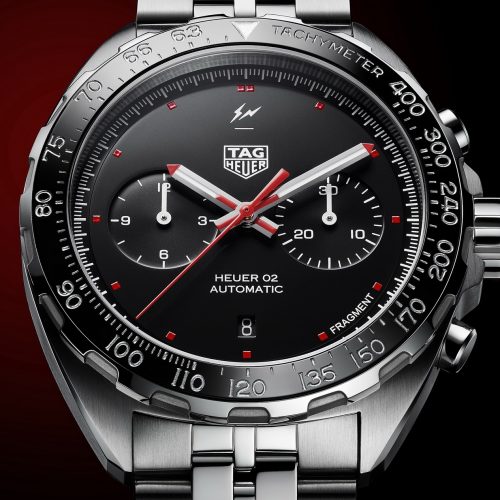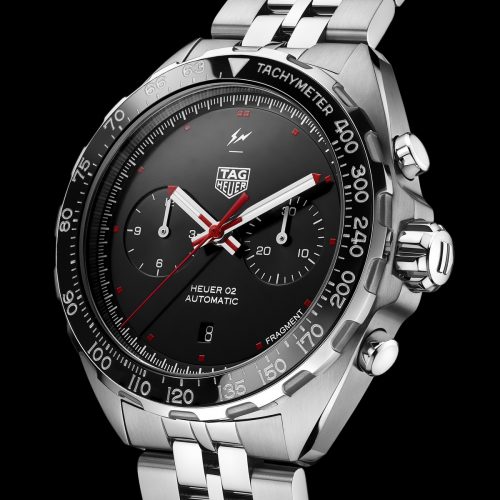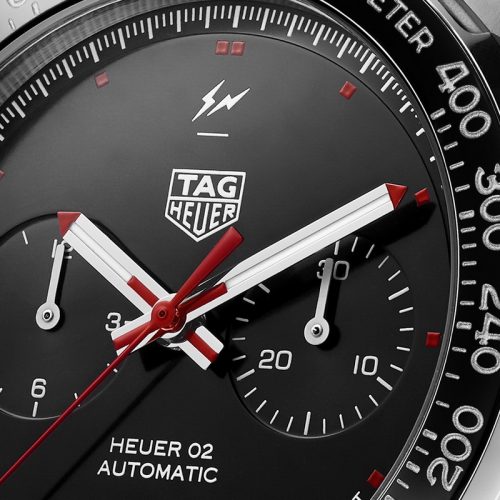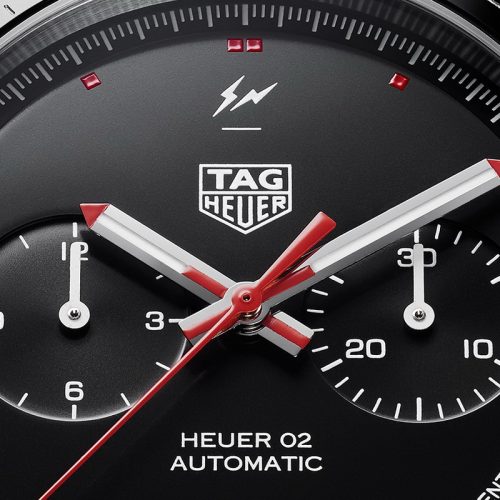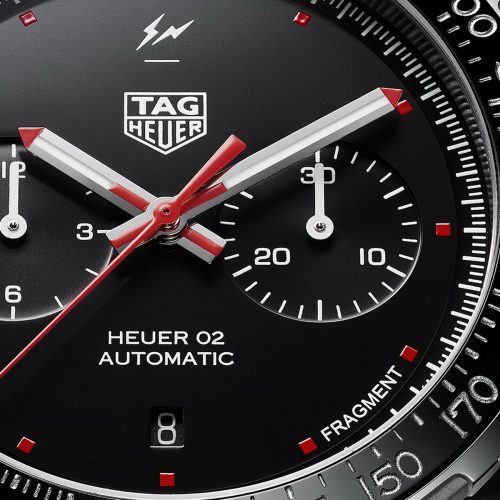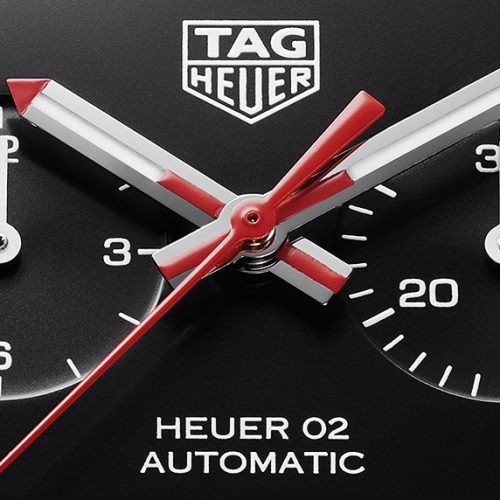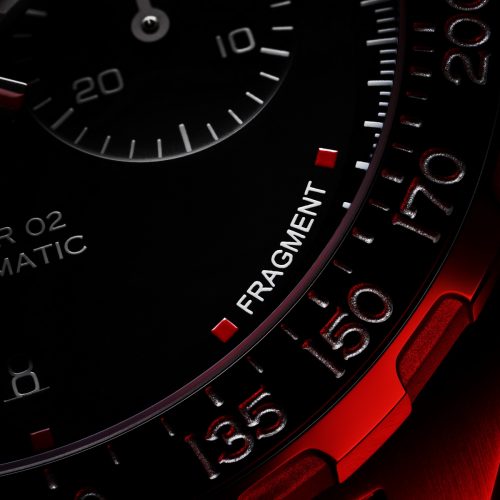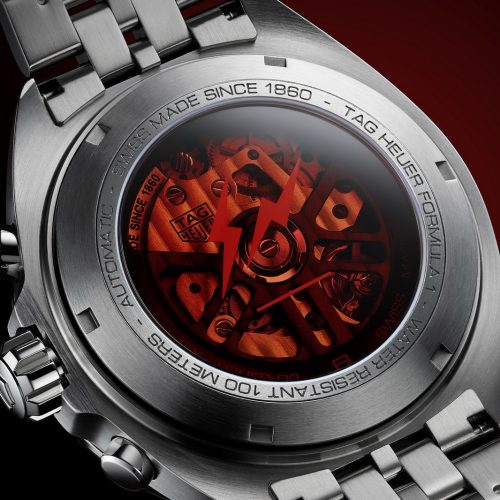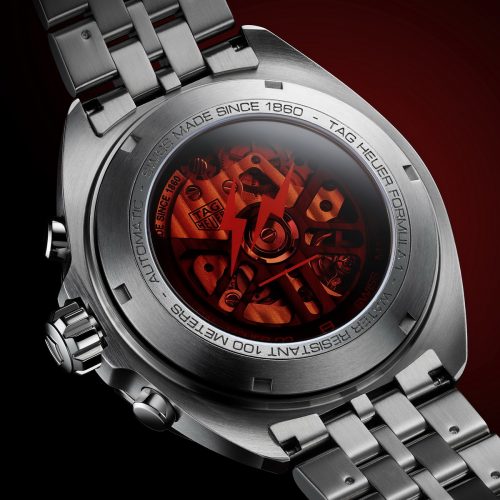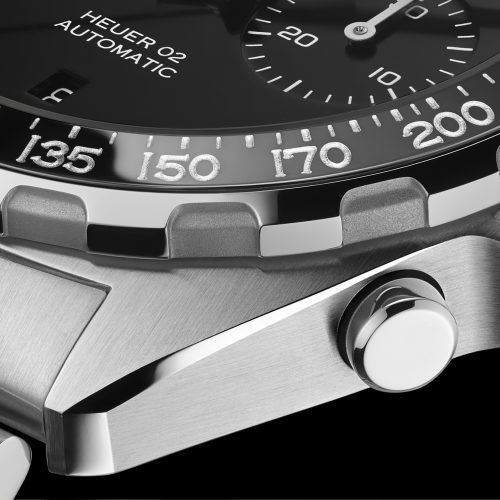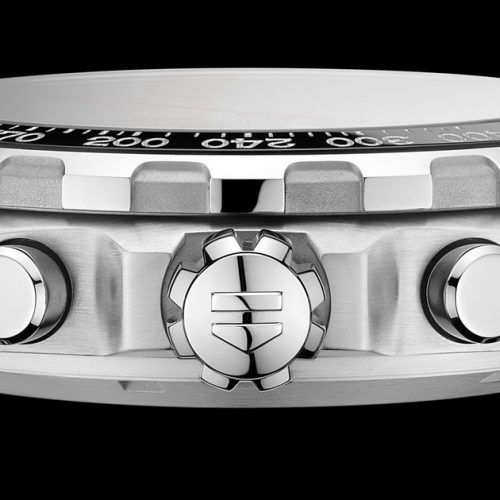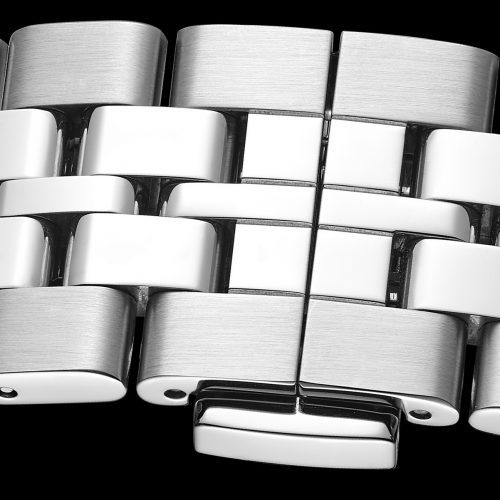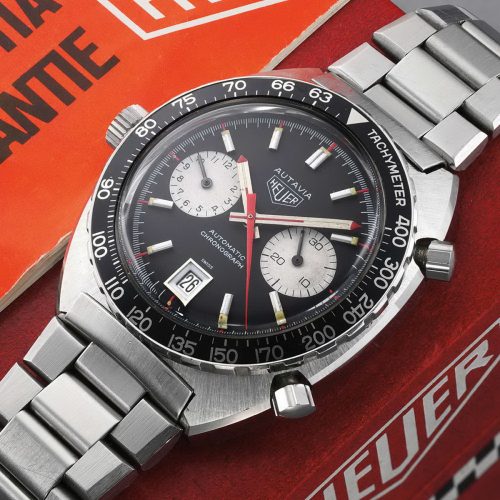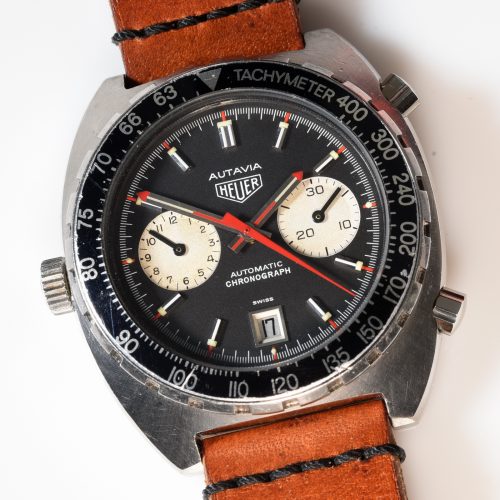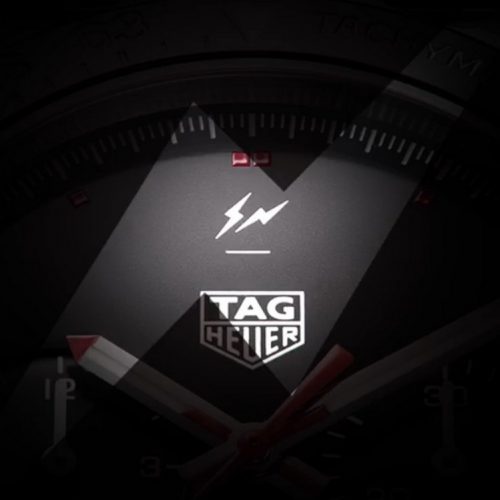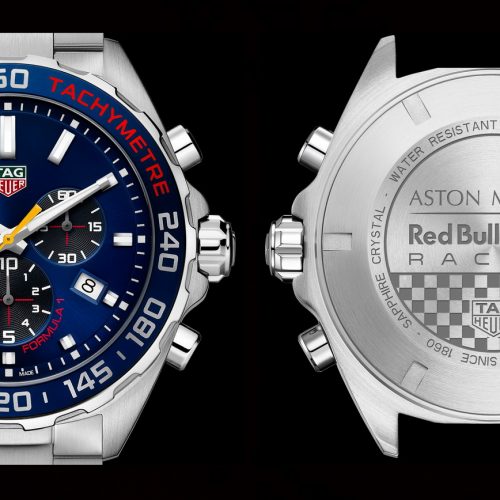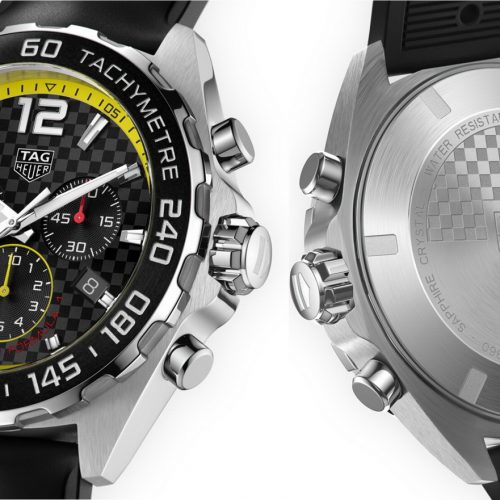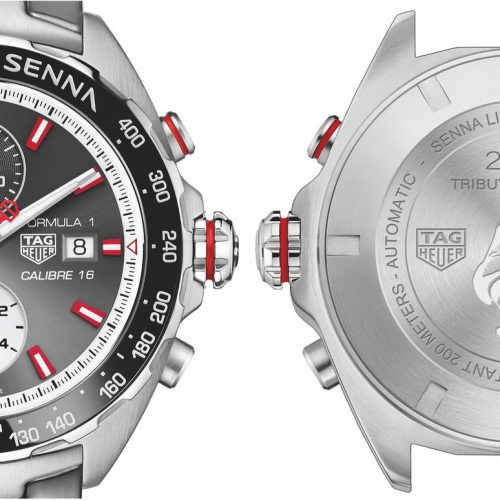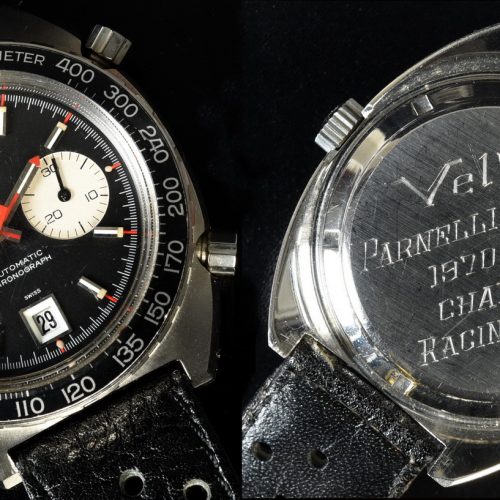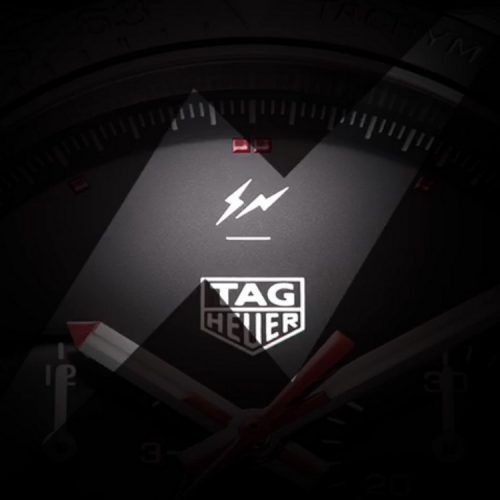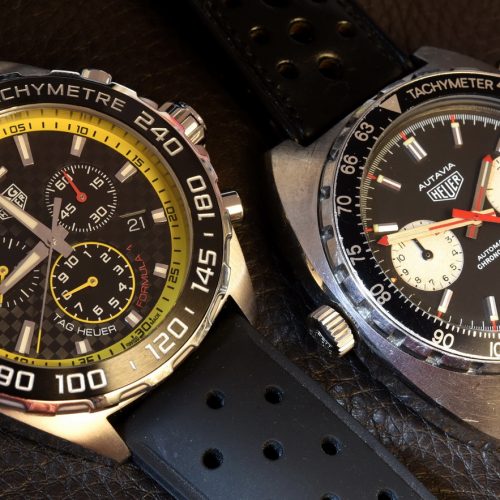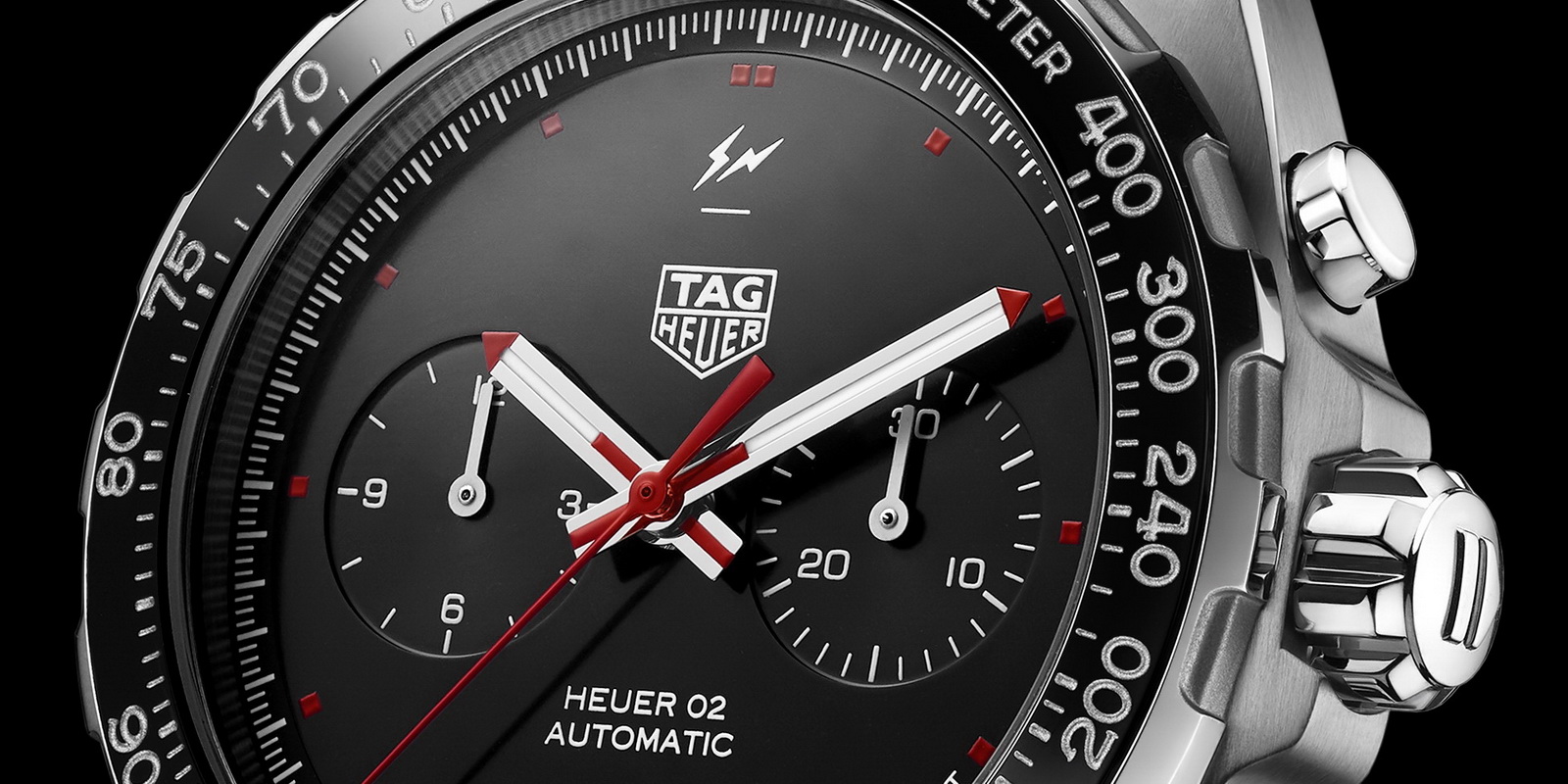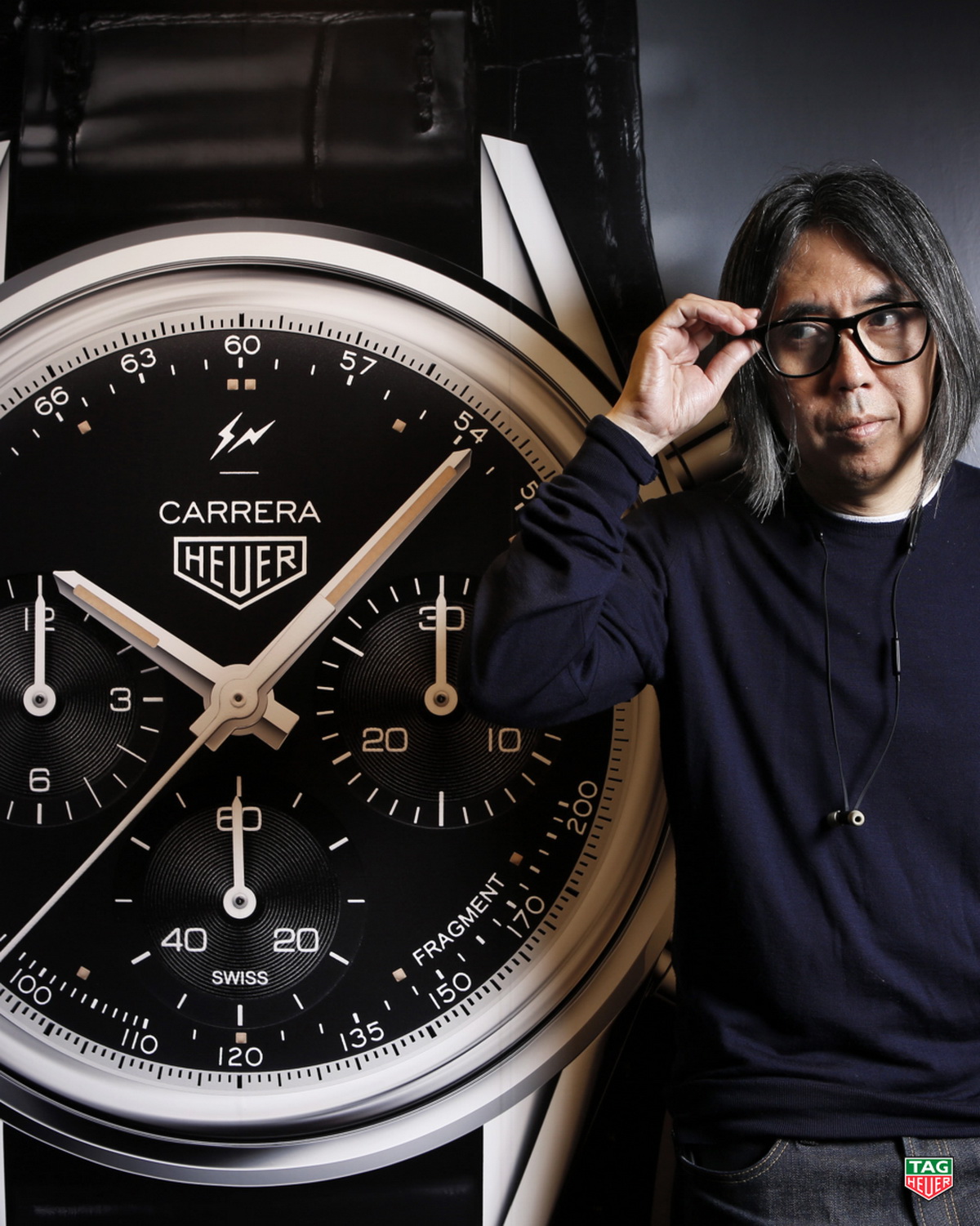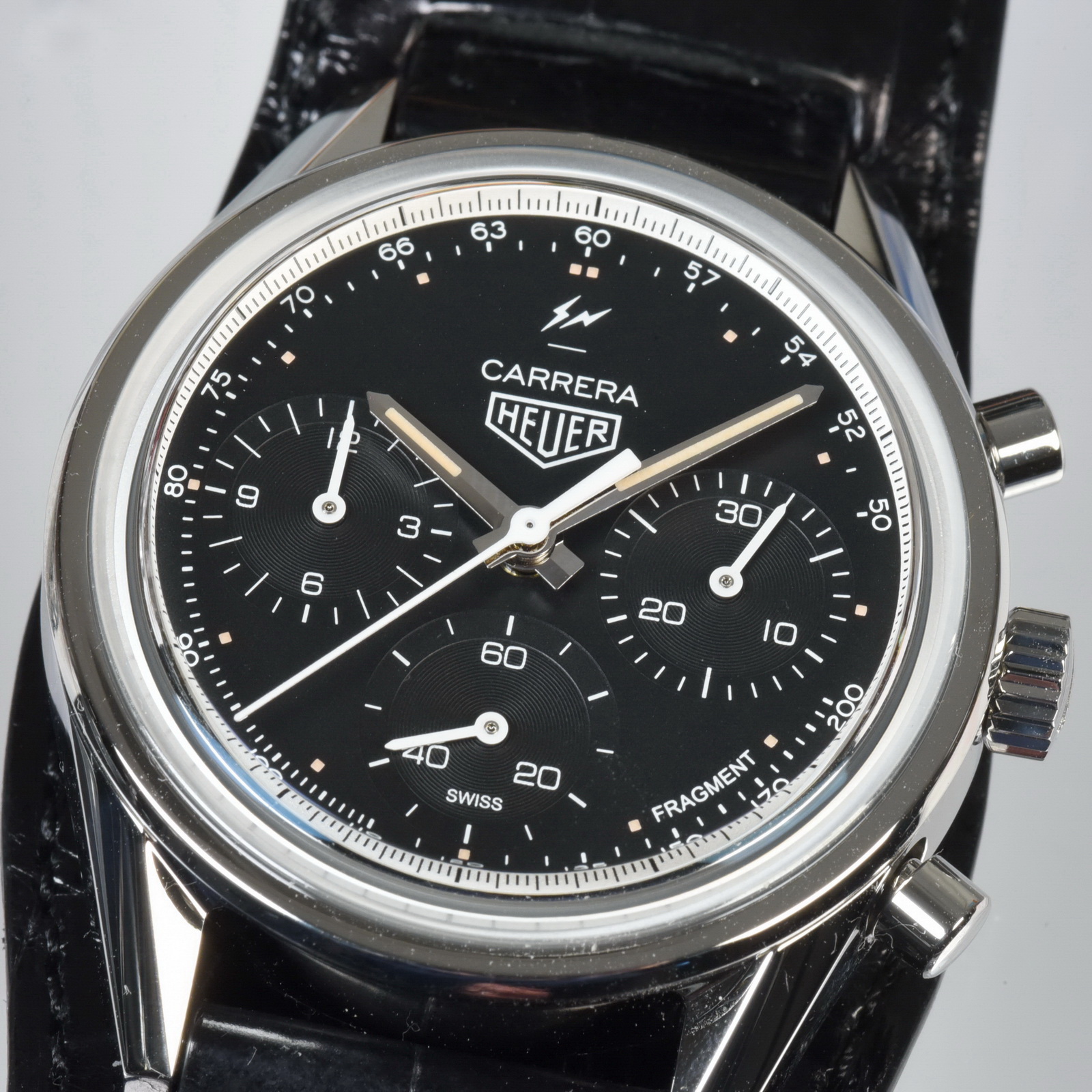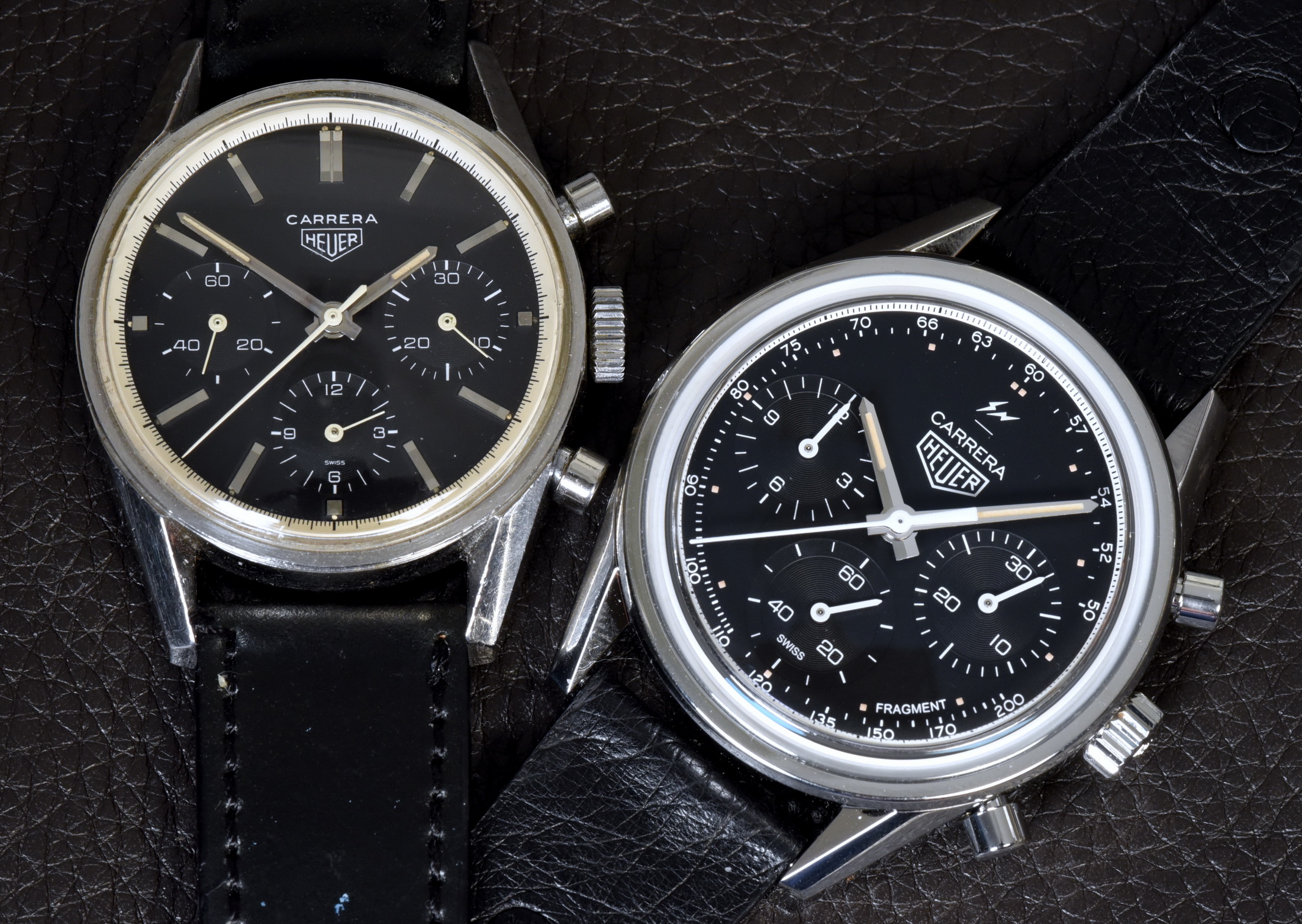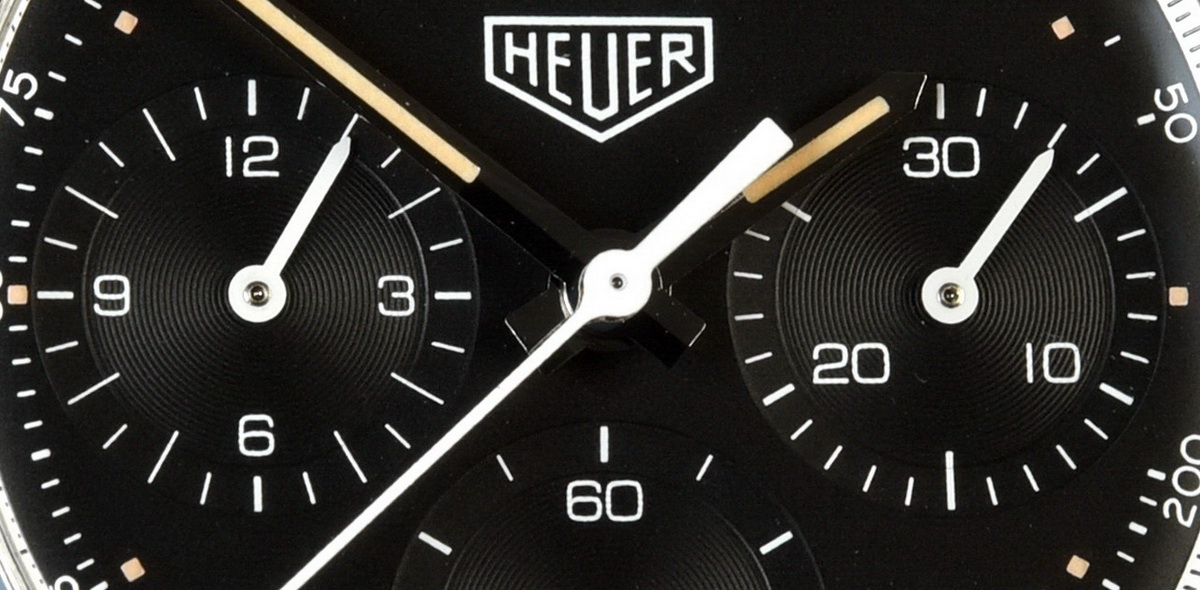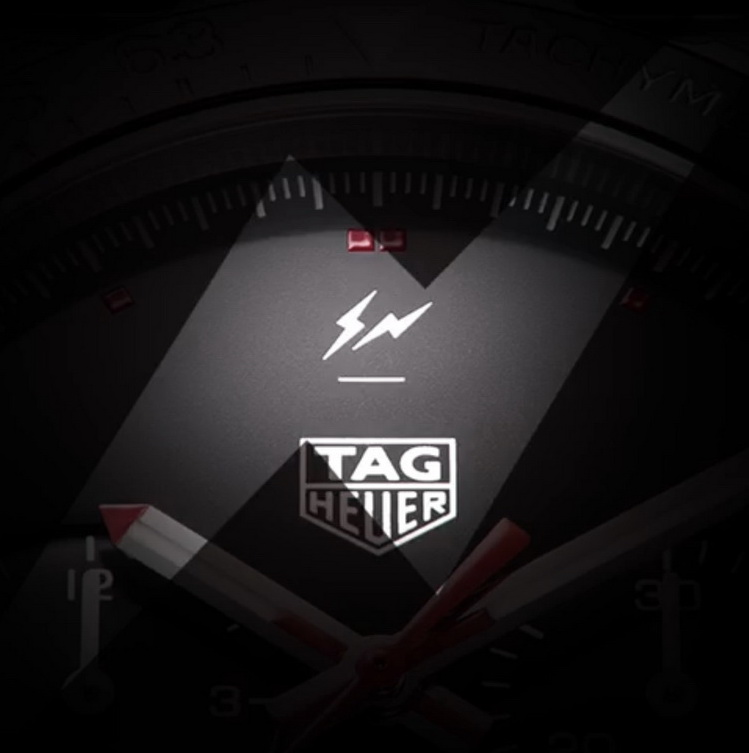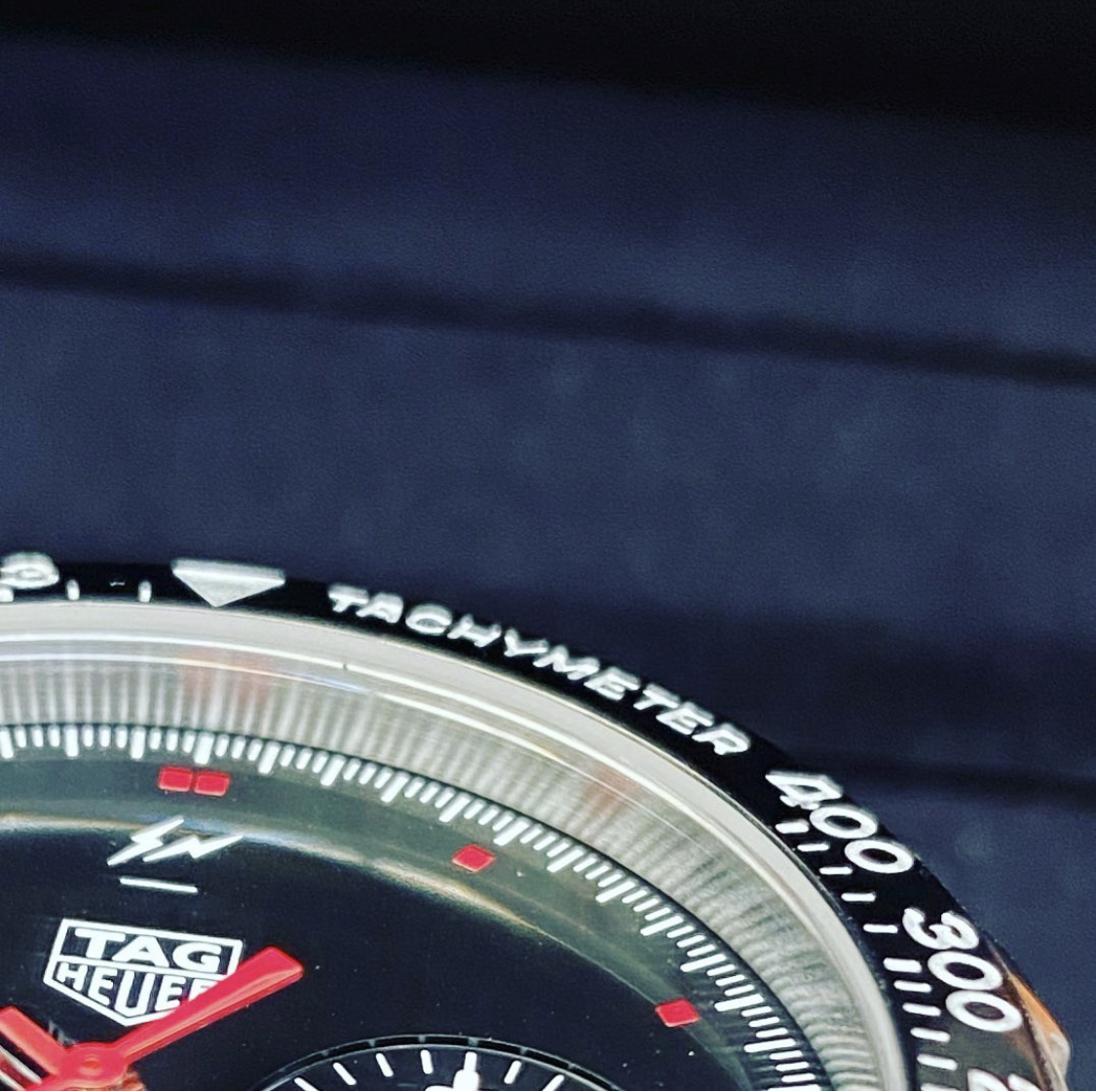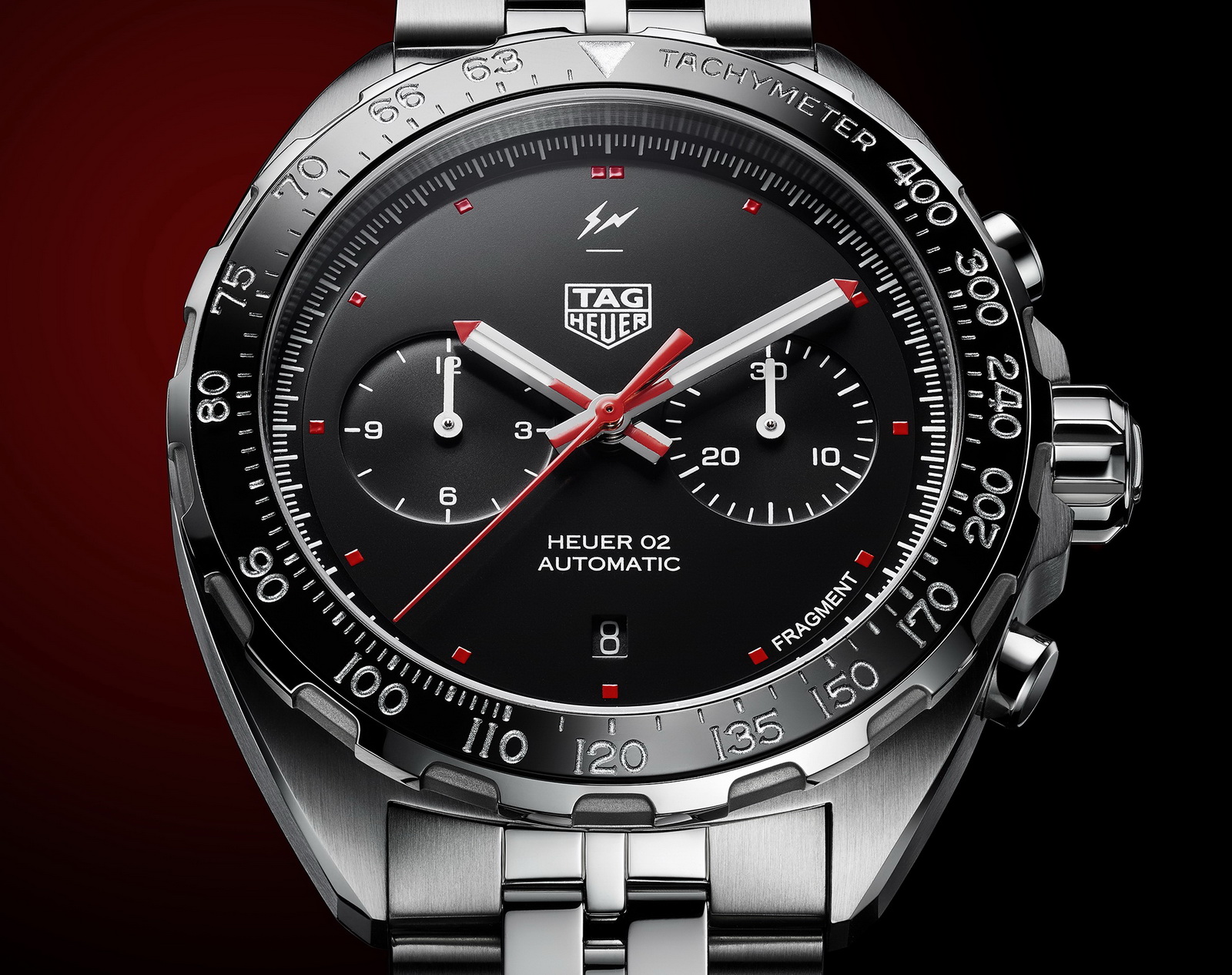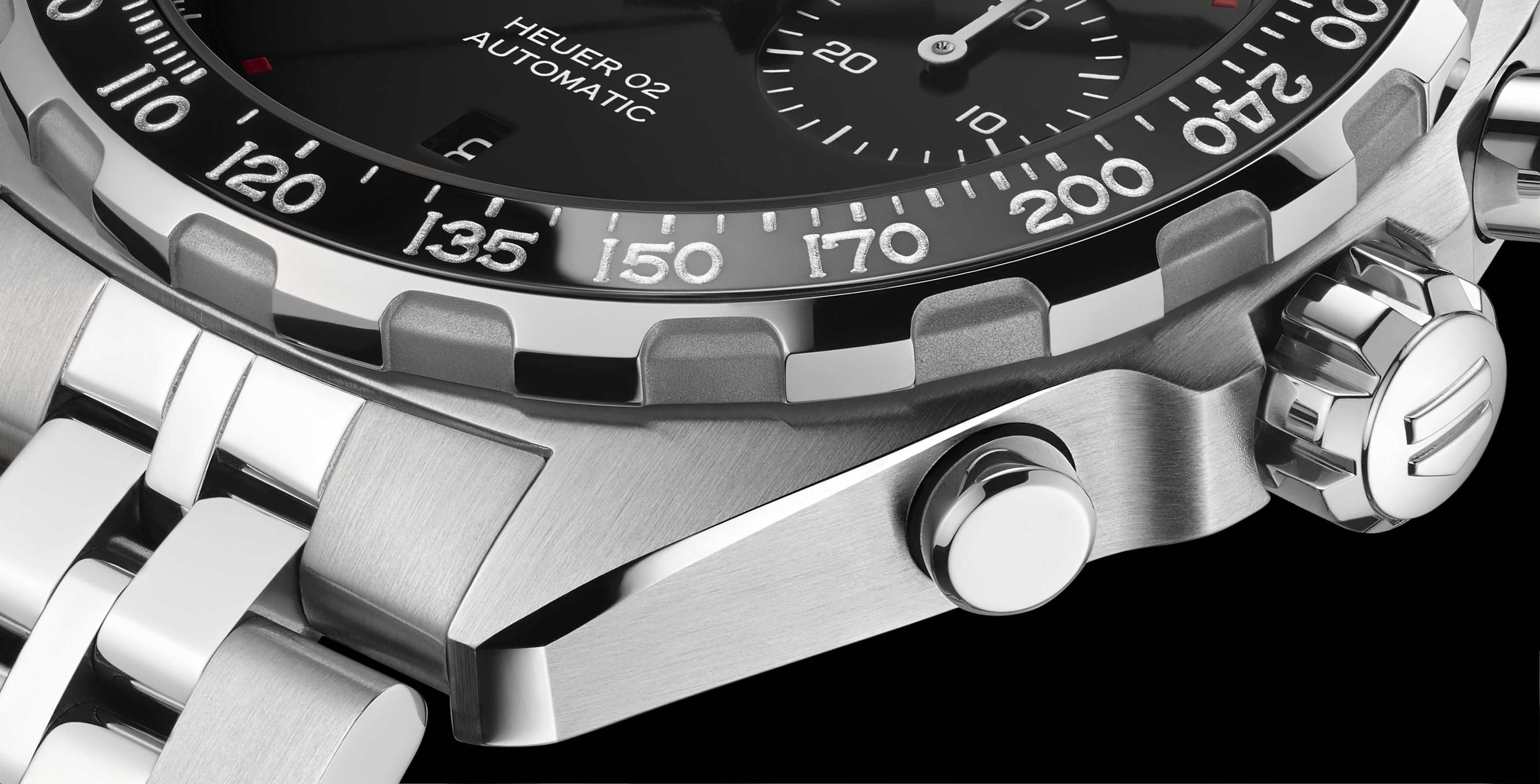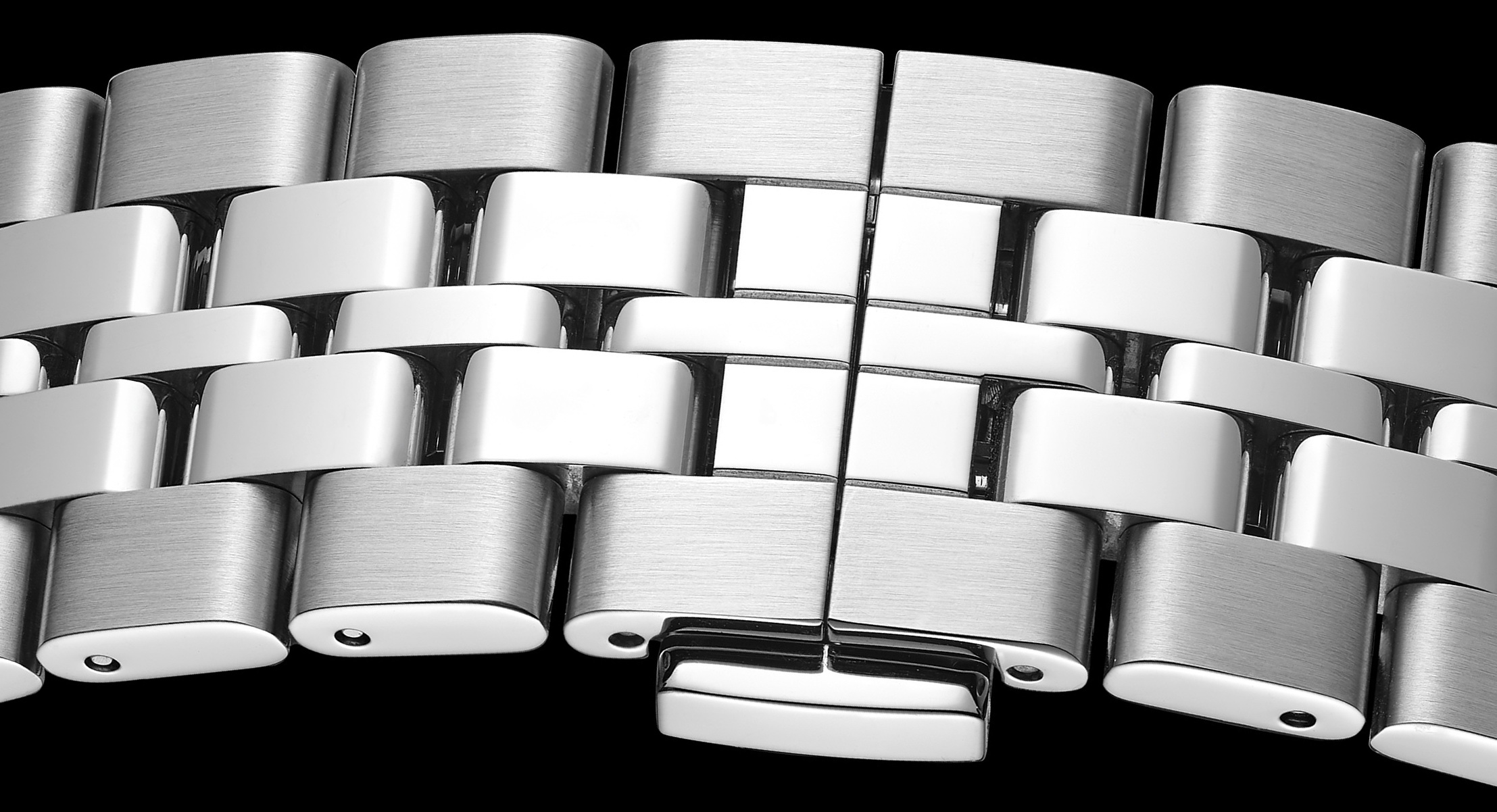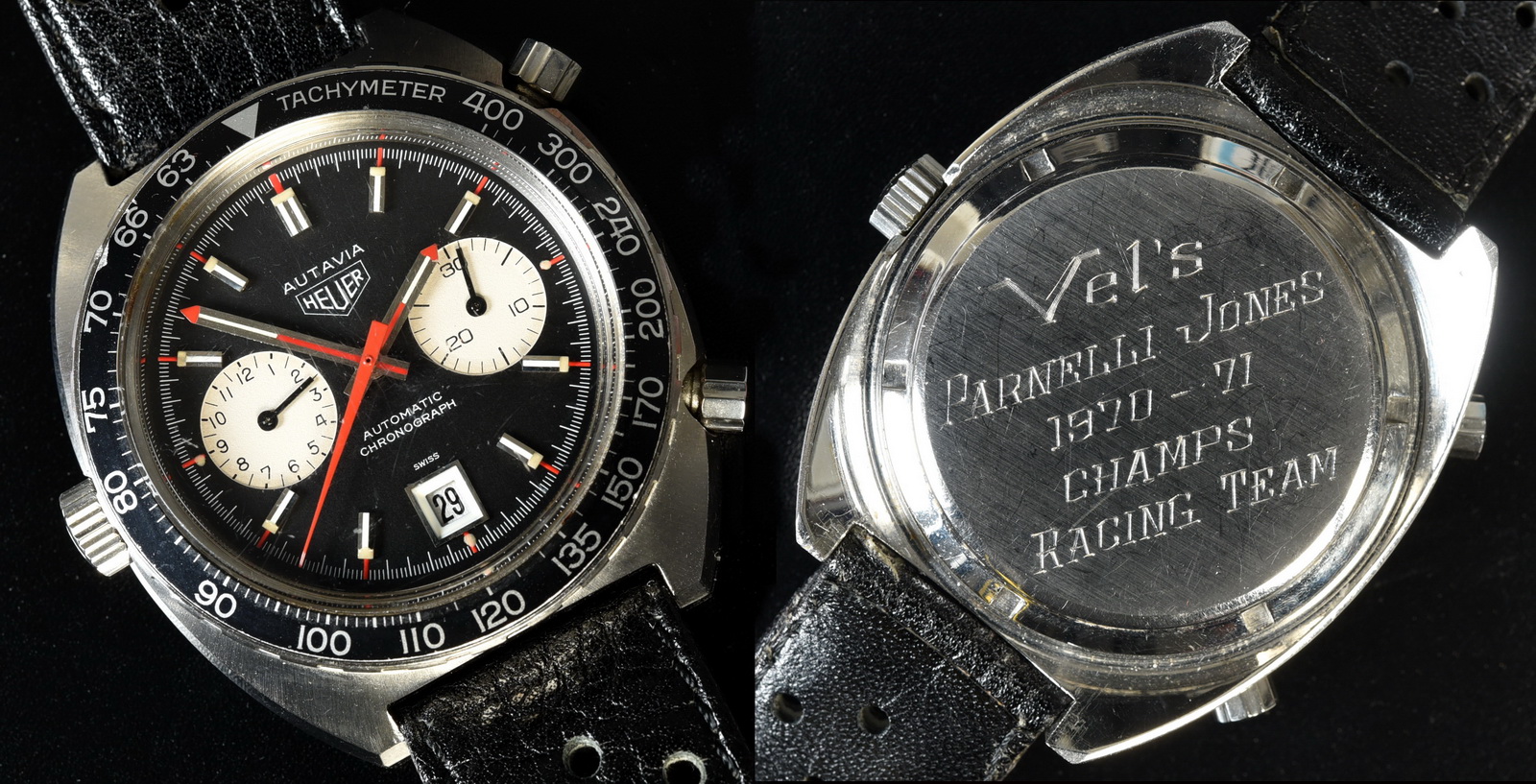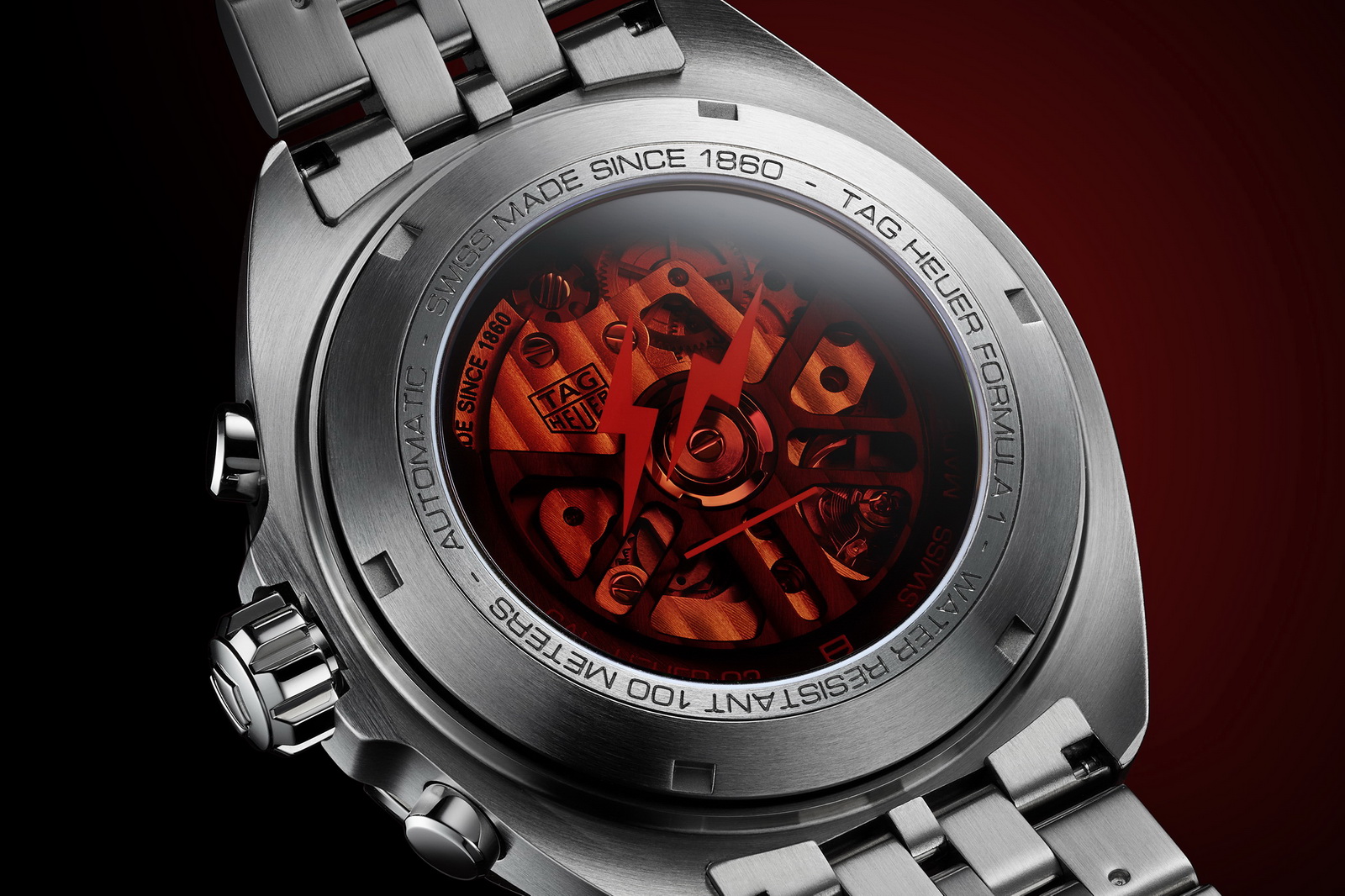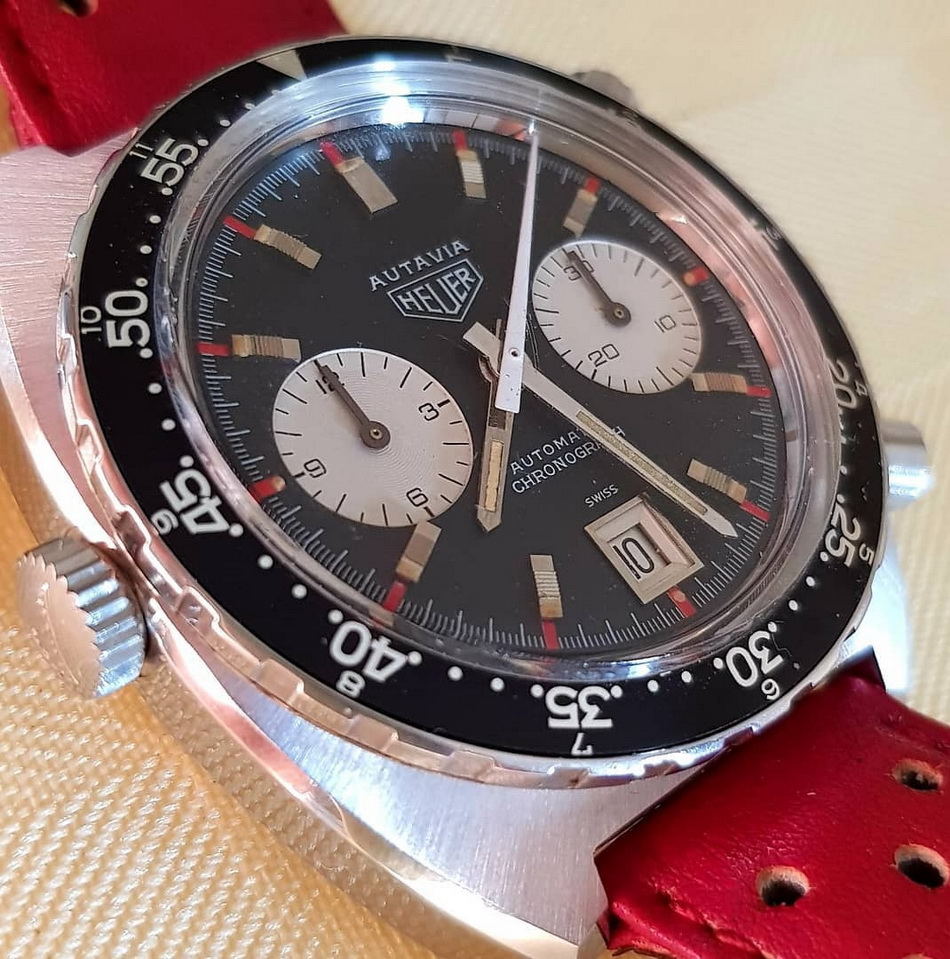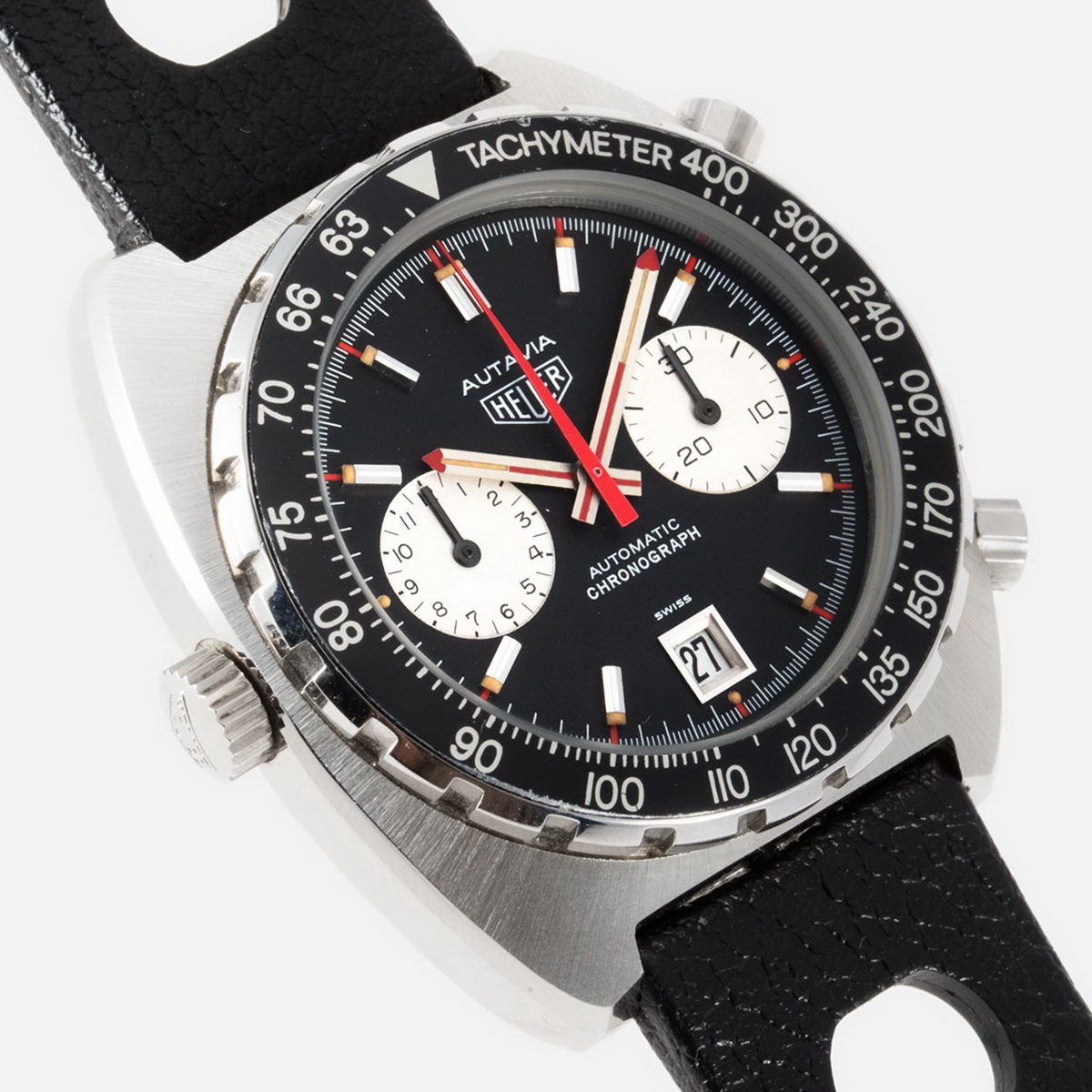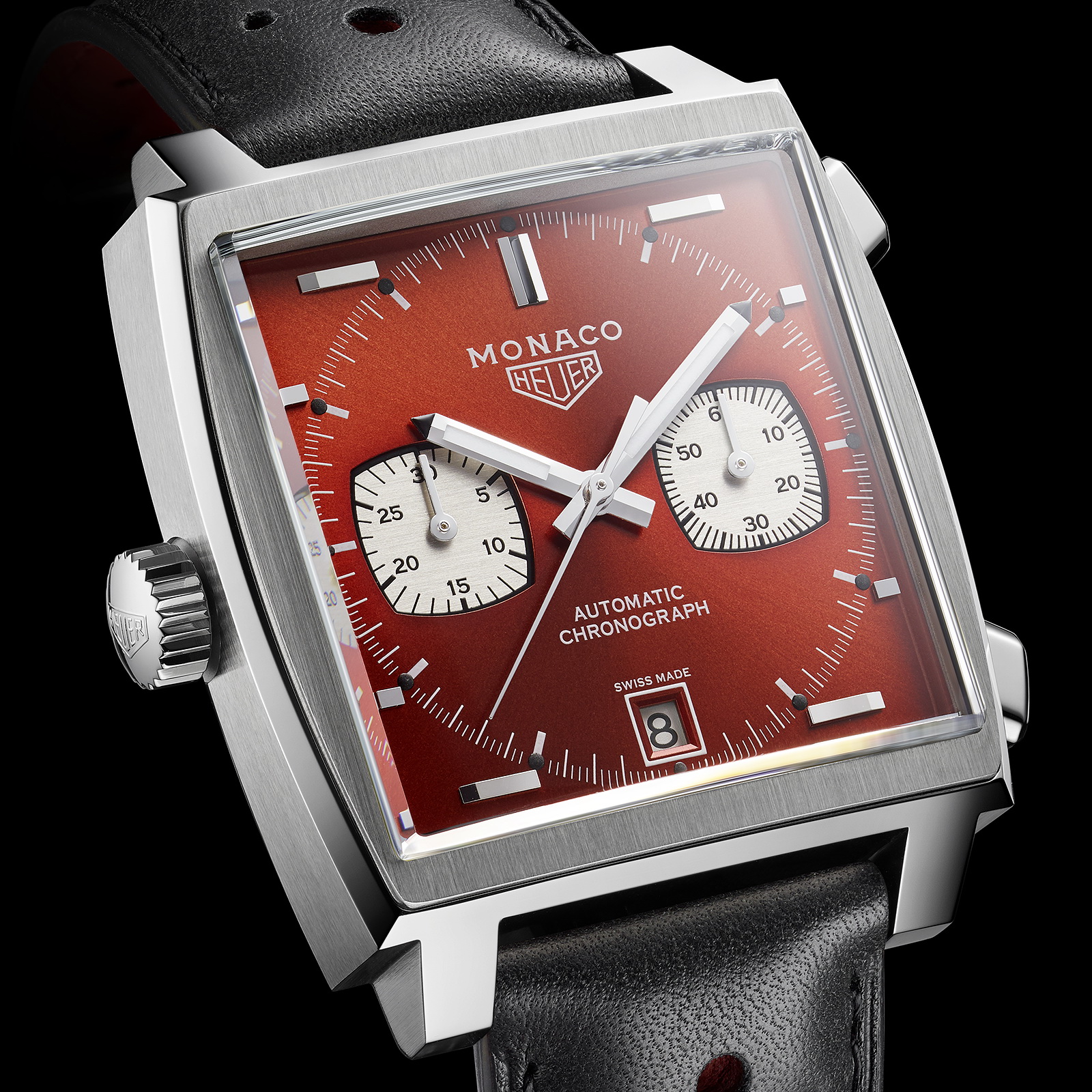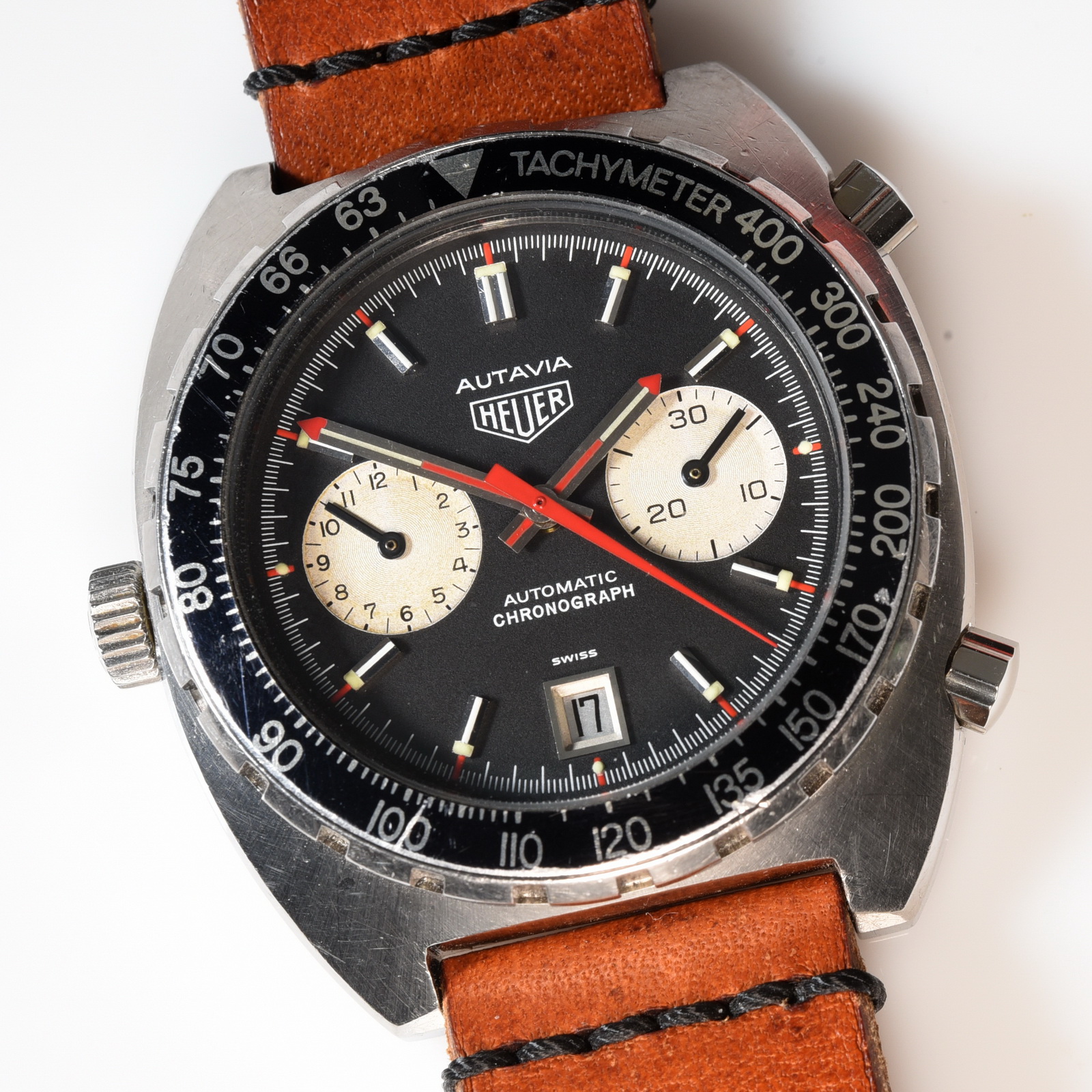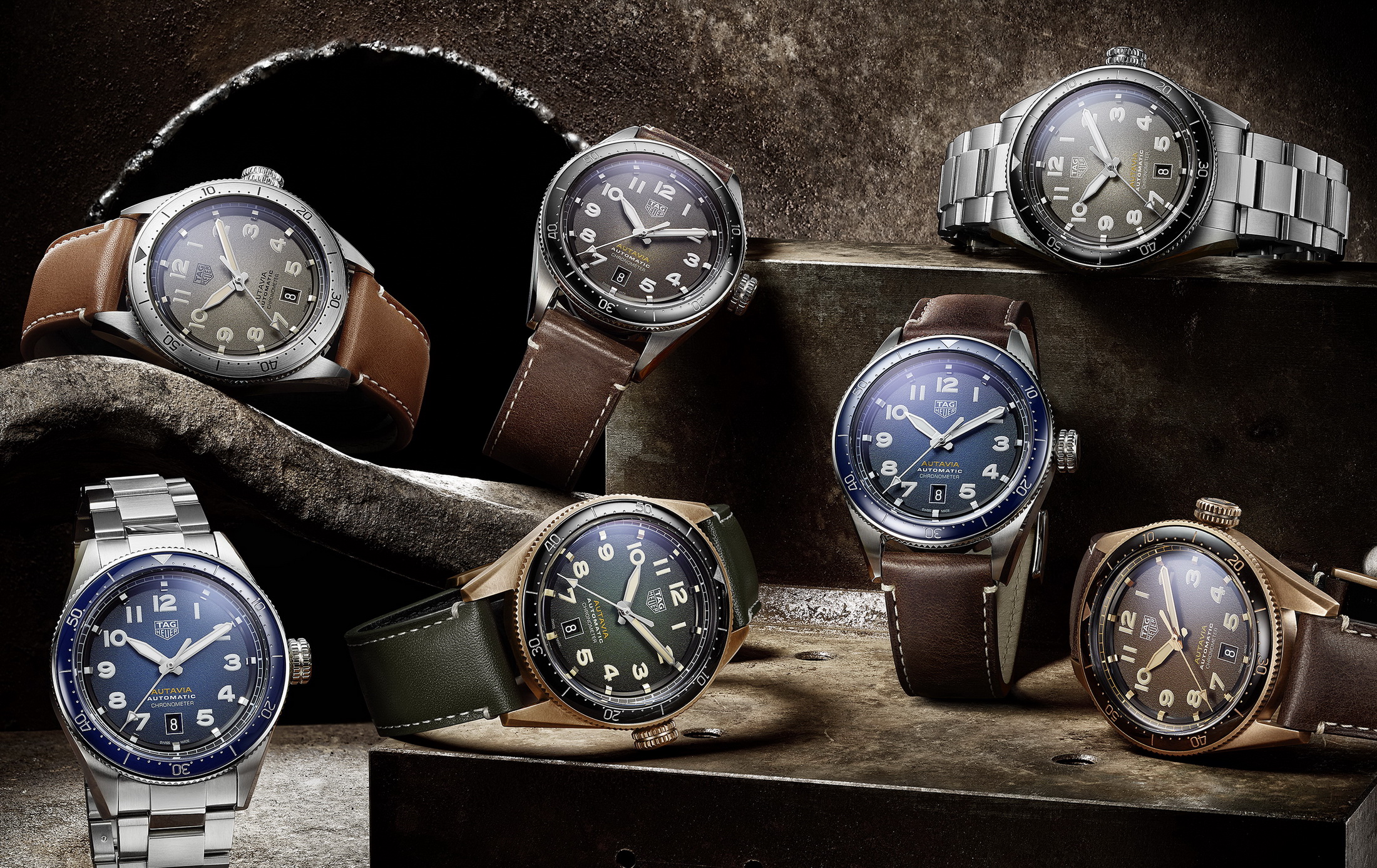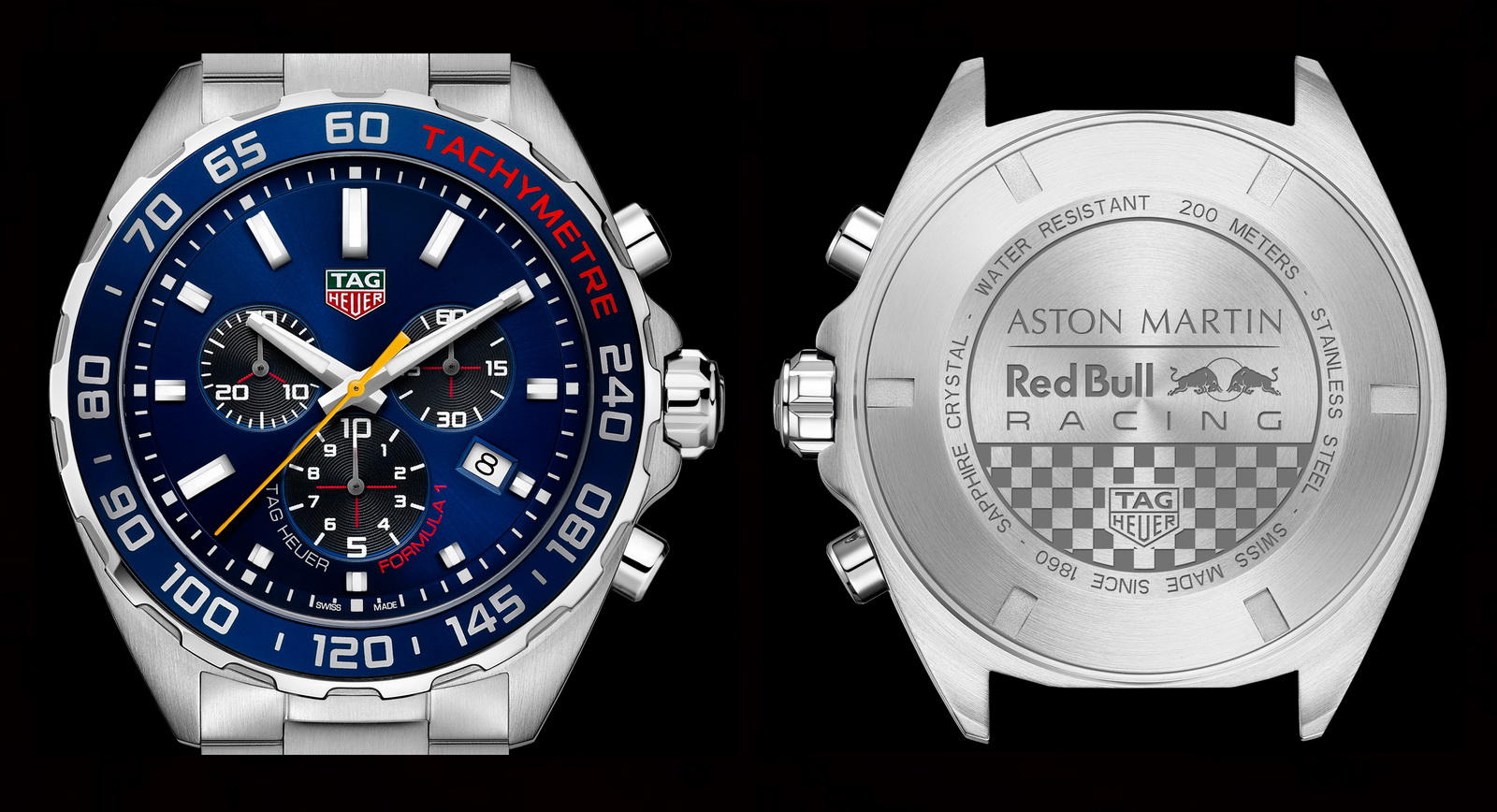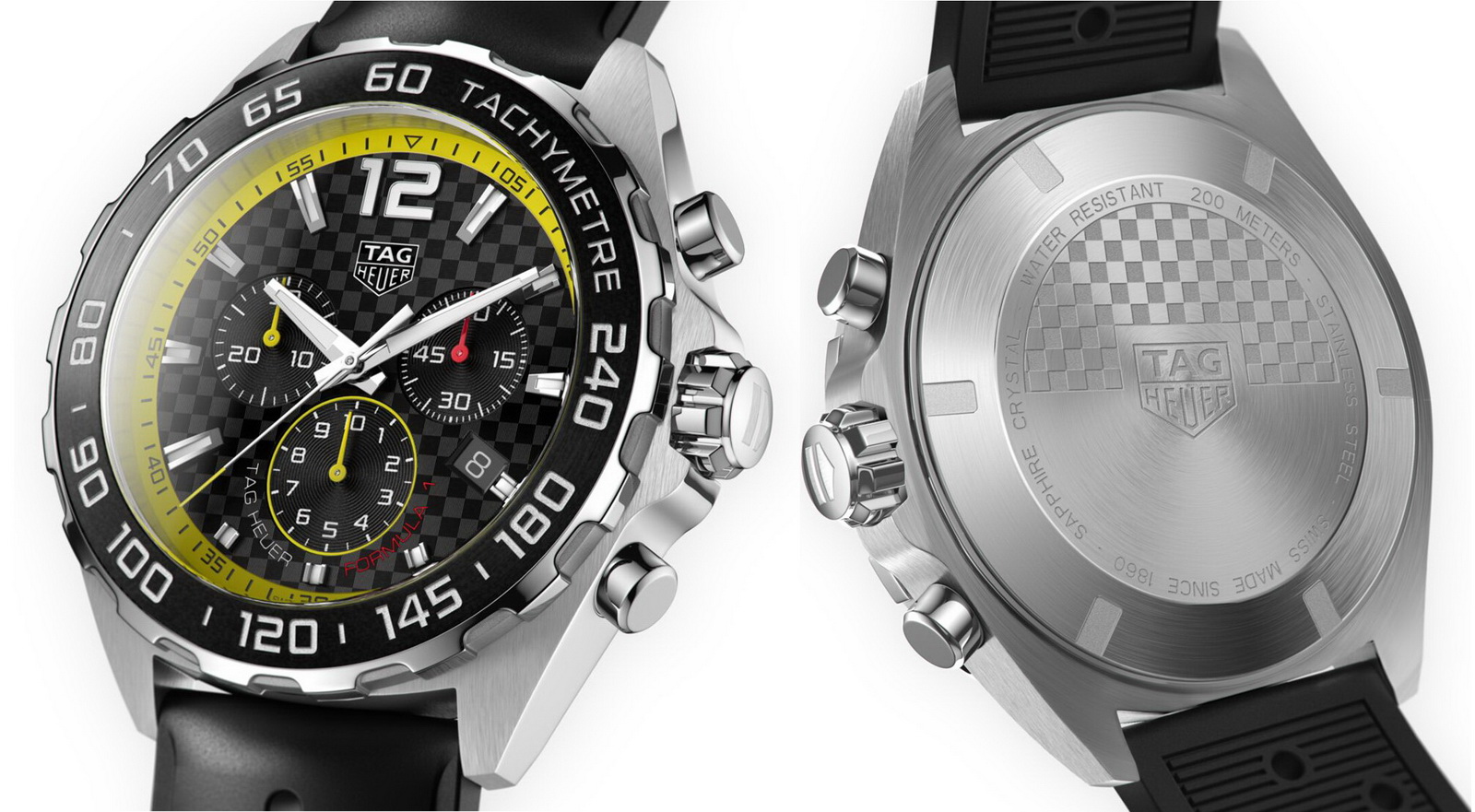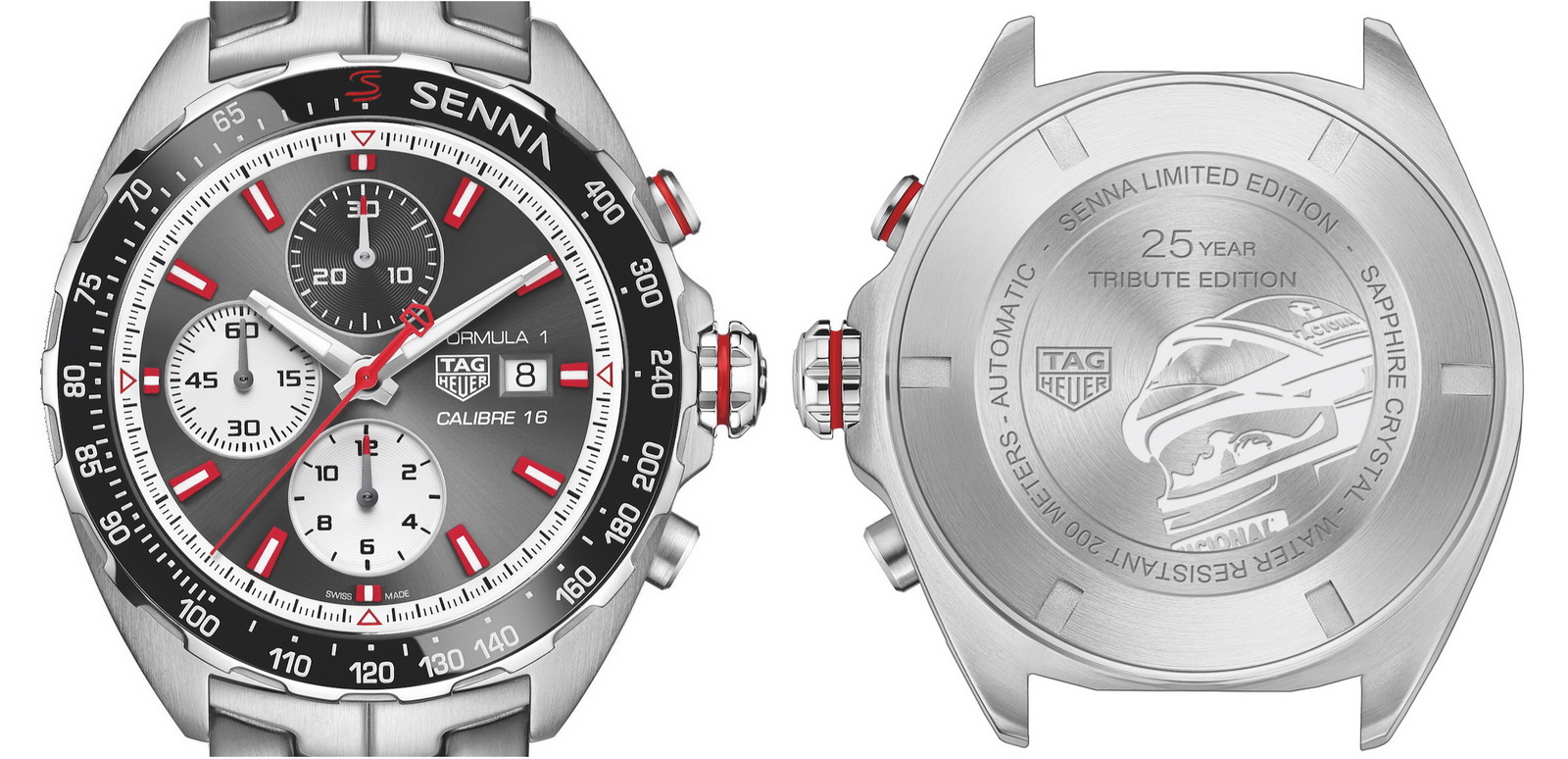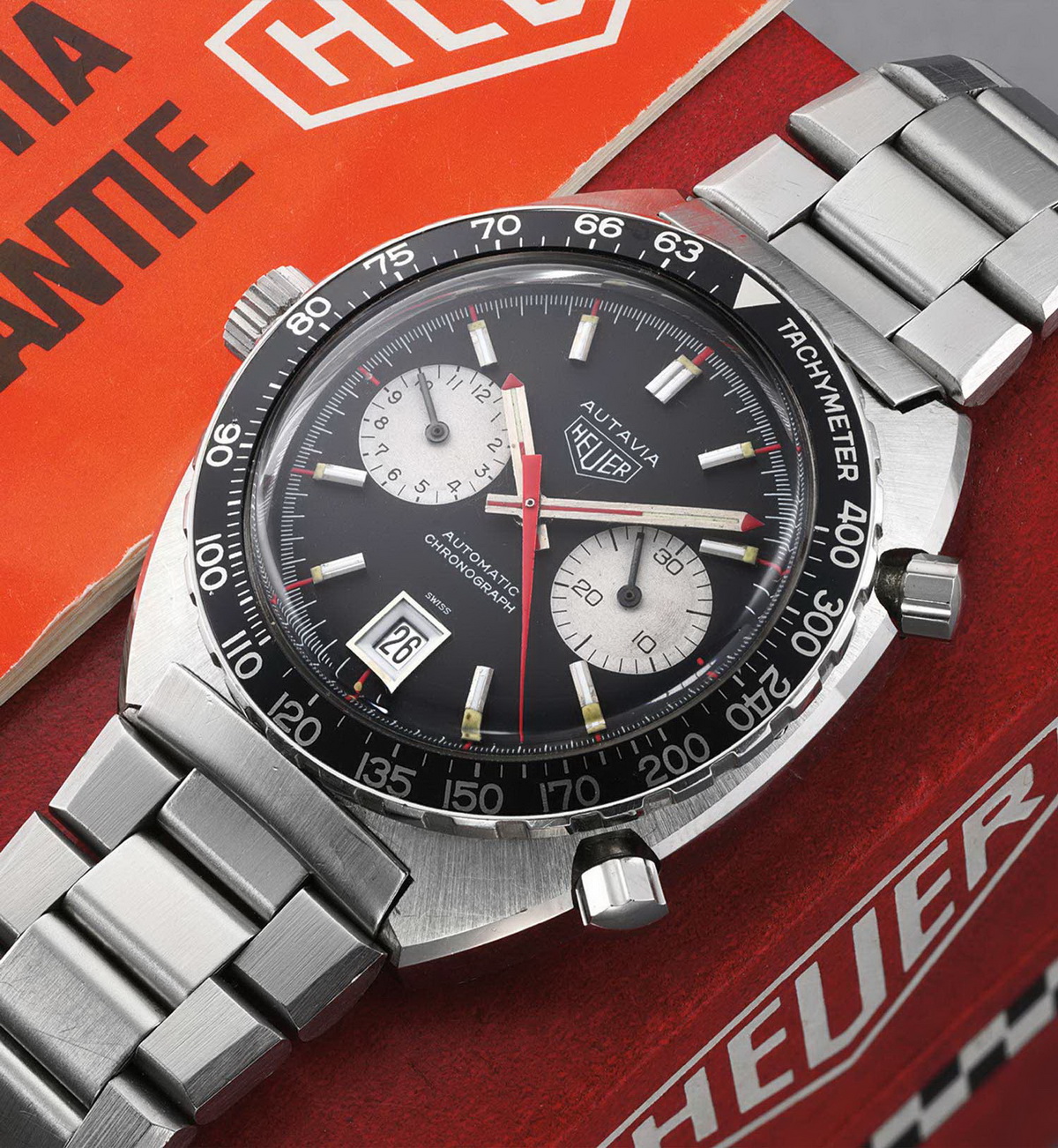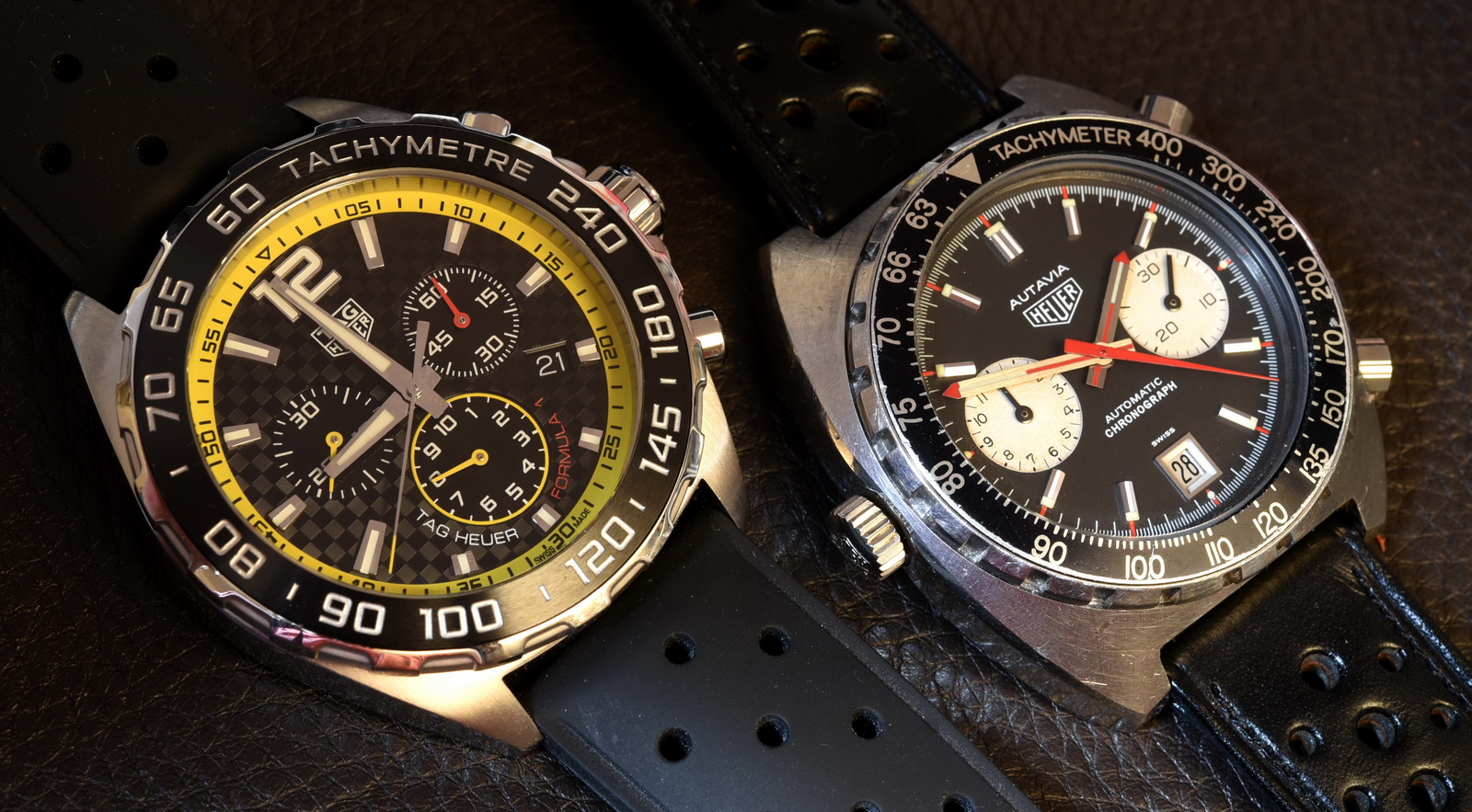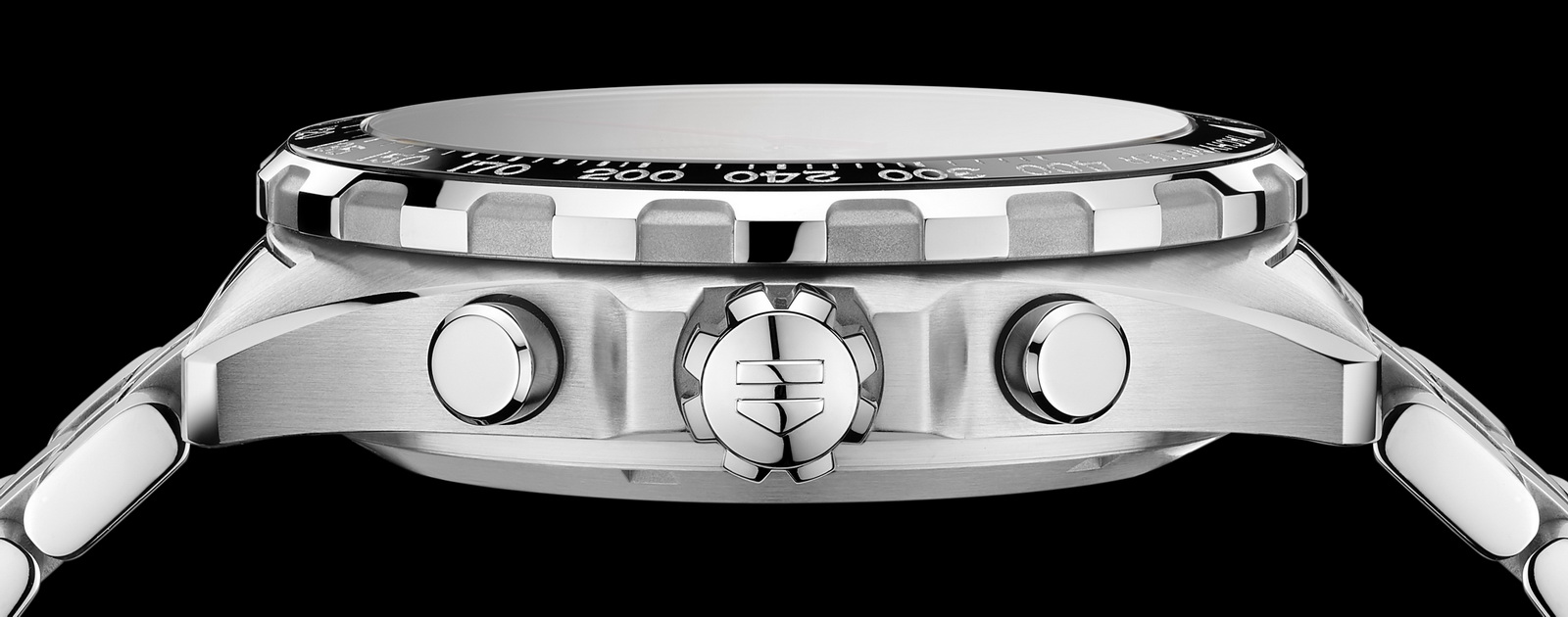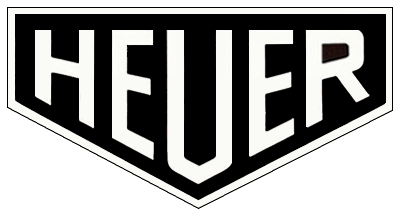TAG Heuer did a strange thing back in November 2018. The Swiss watch brand went far outside the box, in retaining Hiroshi Fujiwara, the founder of Fragment Design and a legend in the world of streetwear, to design a limited edition of the Heuer Carrera.
The elevator version is that Fujiwara explored the TAG Heuer archives and selected the Carrera Reference 2447 NT (circa 1967) as his starting point; TAG Heuer then made the required design modifications to the case so that “glassbox” case could accommodate the Heuer 02 in-house movement; and Fujiwara then tweaked the watch with some accents and decorations from the Fragment Design portfolio.
The most significant differences between the Fragment Carrera and its vintage predecessor include replacing the applied metal markers with lume dots, increasing the size of the registers, and having the hour and minute recorders across the center of the dial, with the running seconds at the bottom (rather than having the hour recorder at the bottom). In terms of the accents, Fujiwara added the Fragment Design “thunderbolts” at the top of the dial, above the name “Carrera”, and printed “Fragment” at the bottom right of the dial, between the markers for 4 and 5 o’clock.
My summary of this exercise – Fujiwara found the core elements of one of the best vintage models in the Heuer portfolio, strengthened some of these elements, and branded the watch with modern streetwear accents. Se this Hodinkee posting for my in-depth review of the Fragment Carrera. [emotional elements]
The Fragment Carrera was issued in a Limited Edition of 500 watches, with a price in the $8,000 range. I am the owner of Number 98, and the watch has been one of my favorite watches over the last 18 months. I like absolutely everything about the watch – its origins in Heuer’s vintage portfolio, the dramatic style of the watch, the connection to streetwear, and the reliability and smooth operation of the Heuer 02 movement. For my in-depth review of the Fragment Carrera, see my posting on Hodinkee, from January 2019.
One Hit Wonder?
Back in late 2018, when I was working on my review of the Fragment Carrera, I exchanged some messages with Hiroshi Fujiwara, to learn more about his experience in designing the watch. In chatting about the Fragment Carrera, Fujiwara mentioned that he would be designing a second watch for TAG Heuer. Given my extreme enthusiasm for the Fragment Carrera, you can imagine what has happened over the last 18 months – each time TAG Heuer has “teased” a new watch, I have been looking for that second watch from Fragment.
I was sure that Fujiwara would do one of the five 50th Anniversary Monacos released during 2019, but no such luck. When TAG Heuer showed the new 160th Anniversary Carrera this past January, once again I hoped for the Fragment Design thunderbolts, but was disappointed. A couple of times, I went back and studied the email message from Fujiwara, in which he mentioned this second project for TAG Heuer. He made it sound as though he was already at work on it, back in November 2018. Surely, whatever he was drawing in late 2018, must have been cancelled. I wondered whether Fujiwara was destined to be a one-hit wonder in the vintage Heuer world.
The “Tease” and the Reveal
Hope returned yesterday, June 17, when I saw that both TAG Heuer and Fragment were “teasing” a new watch. Yes, the thunderbolts at the top of the dial told me that this was Fujiwara’s second watch for TAG Heuer.
The tease images from TAG Heuer (above) and Hiroshi Fujiwara (below) were intriguing, and over the last 20 hours, I have studied them from every angle.
These photos raised as many questions as they answered. Clearly, this new Fragment Design watch was inspired by the Viceroy Autavia and its companion models from the early 1970s, but why was there no model name across the top of the dial? The bezel looked more like the bezel from a Formula 1 than the one from the Autavia. And why the “TAG Heuer” logo across the top of the dial, rather than simply “Heuer”? And one of the big questions — which movement would power this new chronograph?
The answer came a few moments ago, when TAG Heuer released photos of the TAG Heuer x Fragment Design Heuer 02 Chronograph. For reasons that I will get to below, the new Fragment watch is part of TAG Heuer’s “Formula 1” collection, but let me begin with my quick and unstudied reaction to the new watch. To my eye and brain, whatever this watch may be called, it appears to be the most interesting and attractive vintage-inspired watch that TAG Heuer has released, and – even though you won’t find the name on the dial — it’s the best looking Autavia released by TAG Heuer since the model was discontinued in the mid-1980s.
The Basics — Fragment Formula 1
Full specifications of the Fragment Design Heuer 02 Chronograph are provided below. [For ease of reference, we’ll refer to this model as the “Fragment Formula 1” or the “Fragment F1”. Despite the temptation to give it a nickname on Day One of its life and the collectors’ love of a model known as a “ShaunTavia”, we will resist the urge to call it the “FormTavia” or “FragTavia”.] The Fragment Formula 1 is housed in a Formula 1 case, which appears to have some minor refinement in some finishes. The bezel is fixed, not rotating, with a Tachymeter scale (on a black ceramic the insert). Powered by the Heuer 02 movement, the chronograph has the hour recorder on the left (at 9 o’clock) and the minute recorder on the right (at 3 o’clock). The Heuer 02 movement has “running seconds” at 6 o’clock, but this hand has been deleted on the Fragment Formula 1, just as the original automatic Autavias powered by the Caliber 11 / 12 movements had no running seconds. There is a date window at 6 o’clock, however, the metallic frame has been deleted.
TAG Heuer has created a new style bracelet for the Fragment Formula 1 chronograph, a five-row stainless steel bracelet, with a folding butterfly clasp.
The Fragment Formula 1 will be sold in a Limited Edition of 500 watches, priced at $6,150 and available from July 27, 2020. The watch will be sold online, at TAGHeuer.com, and through TAG Heuer boutiques.
The Fragment Treatment
In creating this new watch, Fujiwara has followed the same basic playbook as he used with the Fragment Carrera. We’ll go through the Fragment Design formula.
Step One – Select one of the “icons” from the Heuer portfolio. OK, Fujiwara selects the “Viceroy” Autavia, circa 1972. If we had to select the most recognized chronographs in the Heuer racing portfolio, the “Viceroy” Autavia makes the top three (along with the Reference 2447 Carrera and the “McQueen” Monaco). The Viceroy Autavia was the watch that racers could purchase for $88, as a promotion between Heuer and the Brown & Williamson Tobacco Company (maker of Viceroy cigarettes). For the full Viceroy story, see my posting in Hodinkee — How The Number Three Cigarette In America Made Heuer A Household Name.
Step Two – Remove the non-essential elements. (See, for example, the Fragment Design x Bamford collaboration on the El Primero.) OK, just as a sports car should not have any elements that don’t make it go fast, Fujiwara has followed the approach that he took with the Fragment Carrera, deleting the applied metal markers and replacing them with small, but dramatic, red dots. The dial becomes even cleaner with the deletion of any model name, so there is no “Formula One” or “Autavia”.
Step Three – Dial up the drama. With the excess elements removed, Fujiwara can focus on the elements that will add emotion or drama to the watch. Here, we see Fujiwara moving from the white registers of the Viceroy to the black registers of the Fragment Formula 1 and removing the metal frame around the date window. Racing tires are all-black, not whitewalls, and the black date disc blends into the black dial, with no interruption from a frame. Examining the case-back, we find a red sapphire crystal, consistent with the use of red on the Viceroy, back in the 1970s.
Step Four – Add accents to taste. As on the Fragment Carrera, Fujiwara opts for the thunderbolts top dead center and the word “Fragment” between 4 and 5 o’clock. The red crystal on the case-back also gets the thunderbolt treatment.
Red is for Racing
Exploring the elements of the Fragment Formula 1, and reviewing the choices that were made in designing the watch, help us understand the watch, as well as its position in the TAG Heuer collection. TAG Heuer makes watches for adventures, other watches for diving or flying, and other watches for elegant occasions. The Fragment Formula 1 chronograph represents TAG Heuer’s purest form of a racing watch, the combination of the Autavia, the racer’s watch from the 1970s, and its successor in the TAG Heuer portfolio, the Formula One.
From 1962 until 1969, the Autavia was a watch with a black dial and white registers, and no other accent color. In 1969, Heuer introduced red accents to its racing chronographs, with the manual-winding Autavia (Reference 2446C) and the automatic line of Autavias (Reference 1163 MH and 1163 T).
Red remained a favorite accent for the Autavia, until the model was discontinued in the mid-1980s.
In 2019, TAG Heuer celebrated the 50th Anniversary of the Monaco with the release of five limited edition models of the model, each with a different color scheme. One message from collectors came through loud and clear – red is for racing. Of the five models, it was one with the red dial that collectors most closely associated with racing.
Yes, red is the color choice for Ferrari and many other race cars; this is the color that evokes the excitement and danger of racing.
Nothing Says “Racing” Like the Tachymeter Bezel
Back in 1969, the first automatic Autavias to use Heuer’s new C-shape case were offered with two different bezels. The black dial Autavia had a bezel marked in minutes and hours, and the white dialed Autavia had a Tachymeter bezel (used to convert time over a measured distance into miles / kilometers per hour). Later, the black-dialed models would be available with the Tachymeter bezel, for example, in the “Viceroy” model.
Whether we are looking at the Heuers, or across the pit at the Omega Speedmasters and Rolex Daytonas, one thing becomes clear – regardless of how infrequently it is used for its intended purpose, the Tachymeter bezel identifies a watch as being made for racing. Engineers like their slide rules, divers must keep track of the minutes, pilots may use a GMT indication or flyback function, but it’s the Tachymeter bezel that decorates the racer’s watch. Ask anyone who appreciates the “Paul Newman” Daytona.
Formula 1 — The Highest Form of Racing
Heuer enthusiasts will be puzzled by the fact that the new Fragment Heuer 02 is marked “Formula 1” on the caseback and is part of TAG Heuer’s Formula 1 collection. There is no doubt or debate that the watch was modeled after the Autavias that resided in C-Shape cases, from the first automatic Autavia in 1969 (Reference 1163) through the last of the line, in the mid-1980s (Reference 11063). So if it looks like an Autavia, and sounds like an Autavia, and walks like an Autavia, why is the new Fragment watch presented as part of the Formula 1 model line-up?
Several factors explain why the new Fragment Heuer 02 is called a “Formula 1”. First, when the Autavia joined the TAG Heuer catalog, upon the introduction of the “three-hand” model at Baselworld 2019, TAG Heuer began an initiative to rationalize the six collections that are included in the catalog. And while the Autavia was associated with motorsports and racing during the 1960s and 1970s, TAG Heuer is currently positioning the Autavia as a watch for adventure.
So rather than being seen as a racing watch, the Autavia is being presented as a watch for adventures such as flying, diving or driving. In an interview with Hodinkee, TAG Heuer creative director Guy Bove referred to the new Autavia as being TAG Heuer’s “Jeep”. Not the most luxurious vehicle, and not the fastest one on the track, but a multi-purpose vehicle for adventures.
By contrast, the Formula 1 collection is TAG Heuer’s pure play in motorsports. Yes, you can look at various models in the Autavia portfolio and make the case for other adventures, but it is difficult to look at a Formula 1 chronograph and suggest that it is designed for flying, diving or yachting. Pure and simple, the Formula 1 collection is about speed and racing.
Second, while it seems to have gone largely unnoticed, from the introduction of a new generation of Formula 1 models in 2015, most models of the Formula 1 have come to inhabit cases derived from the Autavia’s C-shape cases of the 1970s and 1980s. And it makes sense. With the Autavias’ popularity as racing chronographs in the 1970s and 1908s, this look was has come to be identified with motorsports. It only makes sense that these same cases would be perfect housings for today’s TAG Heuer Formula 1 watches and chronographs.
Finally, TAG Heuer seems to be moving away from positioning its model lines in tiers, based on their price points. Under the brand’s new approach, the six collections (Autavia, Carrera, Monaco, Formula 1, Aquaracer and LInk) are differentiated by their styles and intended purposes, rather than their prices. The Formula 1 will no longer occupy the limited position as the “entry level” watch for the newcomer to TAG Heuer, rather it is a racing watch that crosses a broad range of price points. Offering the Fragment Formula 1 Limited Edition, with its Heuer 02 movement, certainly sends the message that the Formula 1 is no longer the “entry level” watch for high school graduations and people buying their first “real watch”. With the introduction of the Fragment Formula 1, the collection now covers the entire range from “accessible” luxury to “aspirational” luxury. This is a watch for enthusiasts.
Yes, there may be Formula 1 models to lure newcomers to the TAG Heuer display case, as there will also be Carreras and Aquaracers in this position, but the Formula 1 collection will not be constrained by this price position. Indeed, we can imagine the day when the Heuer 02T (tourbillon movement) would make the jump from the Carrera to the Formula 1.
Fujiwara Hits the Button — “Return to Default Settings”
Once upon a time, in the year 1962, Jack Heuer decided that the name “Autavia”, which had been used since 1933 only for dashboard timers, would be used for wrist chronographs. I suspect that if there had been Facebook groups and discussion forums, enthusiasts – if there were such people back then — would have howled. So too, when TAG Heuer showed the first three-hand (non-chronograph) Autavias in March 2019, some members of the vintage community objected. But the move made sense to me, and we saw the Autavia promoted from being a one-off model or limited edition to a full-fledged collection in the TAG Heuer catalog. In terms of the marketing dollars and visibility to the public, becoming a full-fledged collection was a big deal for the Autavia. Yes, it had arrived as TAG Heuer’s sixth collection.
Now we have TAG Heuer making an even more dramatic move – taking one of the legendary Autavias, produced over the years 1969 through 1985, and essentially dropping it into a Formula 1 case. Yes, we can expect some of the traditionalists to scream. But to my way of thinking, TAG Heuer is taking a smart step to more precisely define the positions of its six collections. The Autavia will be the “Jeep”, the utility tool for adventures, and the Formula 1 will be the watch for racing enthusiasts. What better way to mark the ascendancy of the Formula 1 chronograph than by allowing it to house one of Heuer’s iconic designs, the Autavia Reference 1163 / 11063 from the golden age of racing, and powering it with the Heuer 02 movement.
Perhaps TAG Heuer needed to turn to someone like Hiroshi Fujiwara to accomplish this transformation, someone outside the watch world. This is no tweaking of TAG Heuer’s current models of Autavia or Formula 1 chronograph. This is not an update or a refresh of either model line. Rather, it is as if Fujiwara has pressed the key, “Return to Default Settings”, and in an instant the Formula 1 chronograph that had been evolving over the last three decades was transformed into the ultimate racing watch of the 1970s. Fujiwara refers to this as “modern vintage”, and this phrase is very useful.
Many of the “modern” elements of the Formula 1 are gone. The carbon fiber is gone; the bright markers and bright white lume are gone; the ticking of the quartz movement is gone. In their place, we have a new watch that evokes the Autavias used by the leading racers of the 1970s, with a minimalist approach. There can be no better way to mark the arrival of the Formula 1 chronograph as TAG Heuer’s ultimate racing watch than to dress it in the style and colors of its legendary predecessor. Some may wonder why TAG Heuer didn’t call it either an “Autavia” or a “Formula 1”, but perhaps the message is that in the year 2020, a watch can be “non-binary” — neither a pure Autavia nor a pure Formula 1. (For those who insist that it have a label, we can point to the “Formula 1” on the case-back and the “CAZ” (Formula One) reference code.) Of course, there is ample precedent for this in the Heuer heritage portfolio, with Carreras that had no “Carrera” on the dial (Reference 2547), and we see the same thing with Monzas, Pasadenas, Silverstones, etc.
To those who will lament the fact that this new Fragment creation is marked “Formula 1” rather than “Autavia”, we can say, “The king is dead; long live the king.” The Formula 1 collection is TAG Heuer’s pure play in racing chronographs, and with the pedigree of the “Viceroy” Autavia and the superb quality of the Heuer 02 movement, the Fragment Formula 1 chronograph wears the crown well. And let’s not worry about the Autavia. This collection will always have its pedigree from the 1960s and 1970s, and will thrive in its new position in the TAG Heuer catalog. There can be supercars, sports cars, SUVs and limousines, but there will always be a place for the Jeep. But the news today is that the Fragment Formula 1 is TAG Heuer’s new champion of racing. Thanks to Hiroshi Fujiwara, I believe that the watch will wear the crown well.
++++++++++++++++++++++++++++++++++++++++++++++++++++
Specifications – Fragment Design Heuer 02 Chronograph (Reference CAZ201A)
Limited Edition – 500 watches, offered through TAG Heuer Boutiques, and www.TAGHeuer.com.
Movement — TAG Heuer Calibre Heuer 02automatic movement; built with column wheel and vertical clutch; frequency 28,800 bph (4 Hz); thickness is 6.9 millimeters and a diameter of 31 millimeters (13-3/4 ligne); power reserve at least 80 hours; offers hacking to synch the watch to a reference time.
Case — Polished stainless-steel case; fixed Tachymeter bezel with ceramic black polished insert; measures 44 millimeters across the dial, with a thickness of 14.2 mm; flat sapphire crystal with double anti-reflective treatment; case-back has red sapphire crystal; water-resistant to 100 metres (10 bar); screw-down crown.
Dial — Black opaline dial; marked in 1/4 seconds (corresponding to 4 Hz frequency); black chronograph hour and minute registers (at 9 o’clock and 3 o’clock); red printed indexes, at 5-10-15-etc. Date window at 6 o’clock; black date disc, with white numerals.
Hands — White lacquered hands for the registers, with red lacquered central hand for chronograph seconds. Time-of-day hands are rhodium-plated with SuperLuminova inserts.
Bracelet — Polished stainless steel, fine-brushed, in five-row pattern; butterfly clasp with safety push buttons
++++++++++++++++++++++++++++++++++++++++++++++++++
Jeff Stein
June 18, 2020
